Webcast and presentation
Download the podcast (MP3 30 MB)
Download the presentation (PDF 6.0 MB)
Transcript
View the 2024 Q1 results presentation and read the transcript slide by slide
Download the podcast (MP3 30 MB)
Download the presentation (PDF 6.0 MB)
View the 2024 Q1 results presentation and read the transcript slide by slide
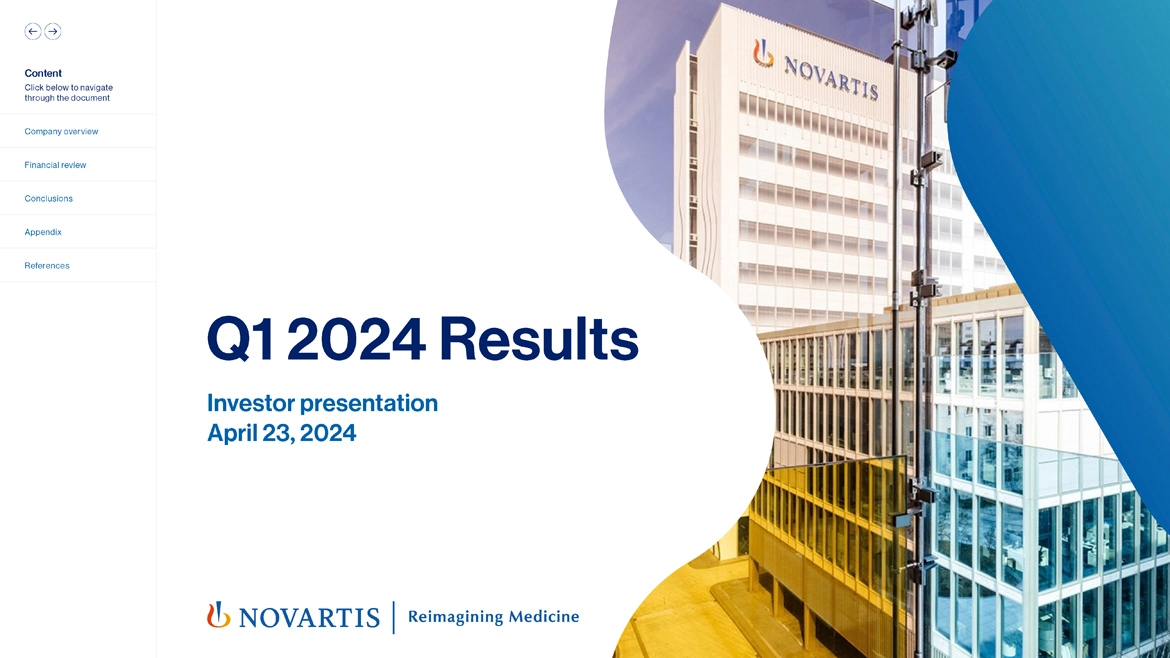
Good morning, and good afternoon, everyone. Thank you for joining our first quarter 2024 earnings call.
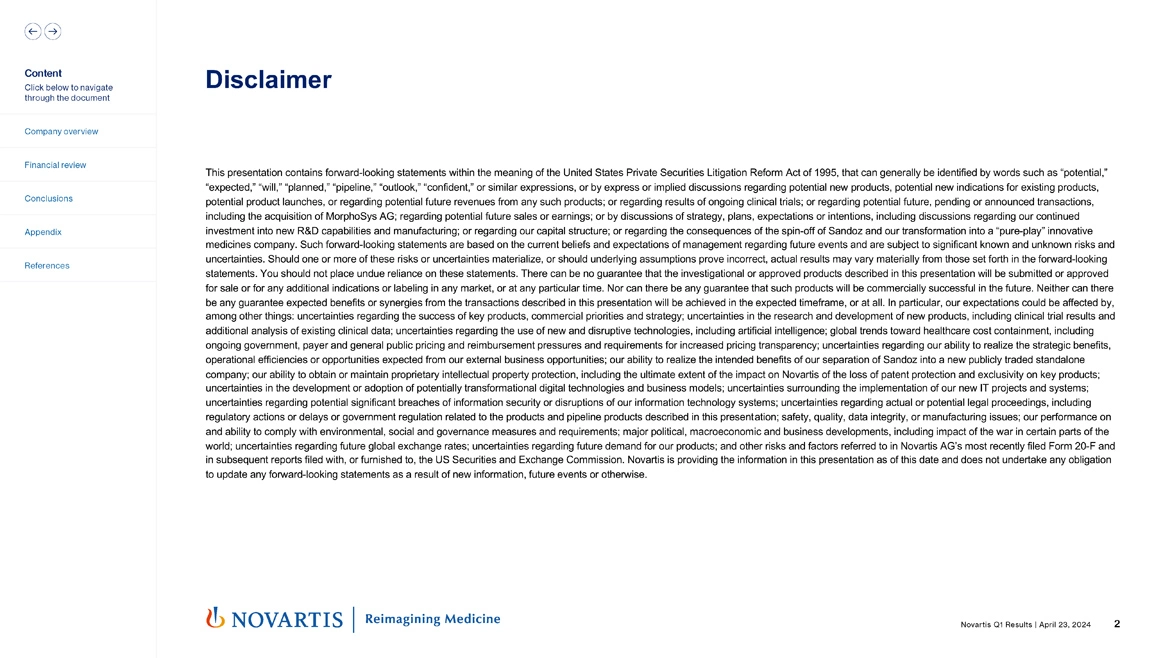
The information presented today contains forward-looking statements that involve known and unknown risks, uncertainties and other factors. These may cause actual results to be materially different from any future results, performance or achievements expressed or implied by such statements. For a description of some of these factors, please refer to the company's Form 20-F and its most recent quarterly results on Form 6-K that respectively were filed with and furnished to the US Securities and Exchange Commission. And with that, I will hand across to Vas.
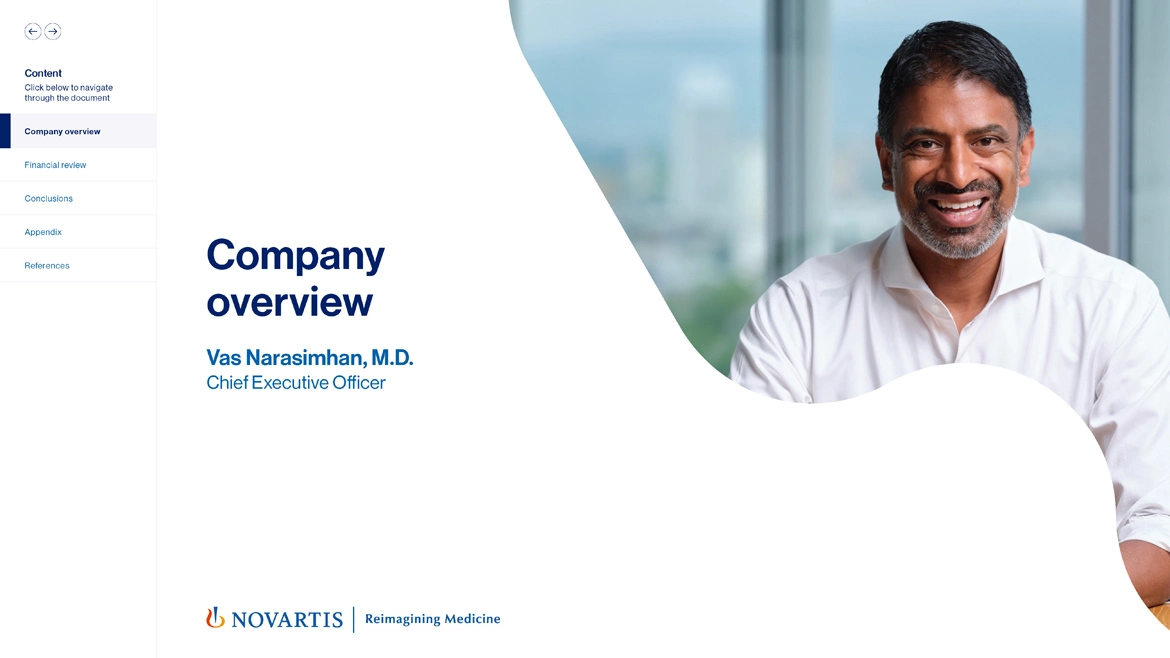
Thank you, Sloan. I'd like to open today's call by first thanking Samir Shah for his incredible tenure as our Head of Investor Relations for over a decade. We're grateful for all of his contributions. We look forward to his continued contributions in the new role at Novartis. And I want to welcome Sloan Simpson, I think Sloan will do an absolutely outstanding job serving all of you as our Head of Investor Relations. I've worked with her for many, many years. I think we're really pleased and grateful to have her on board.
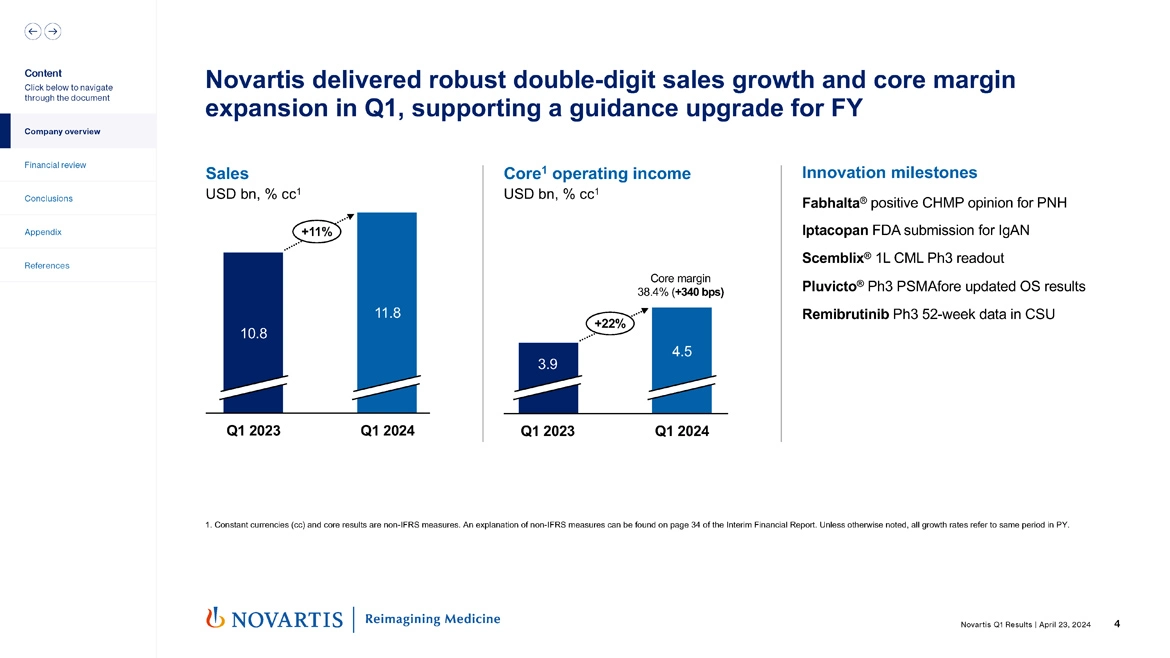
So let's turn to the quarter. Novartis delivered a really strong start to the year with double-digit sales growth, core margin expansion, which enabled us to upgrade our guidance, and Harry will go through the guidance in more detail. Sales were up 11% in constant currency. Core operating income was up 22%. Our core margin reached 38.4% as we steadily march to our goal of 40% plus by 2027.
In addition, we had a number of important innovation milestones in the quarter, which I'll go through over the course of the call. But a few I'd want to particularly highlight, the Fabhalta® positive opinion enables us to launch Fabhalta® in Europe. Scemblix® first-line readout, we think will be very important for a major medicine for the company. And we also had the updated PSMAfore OS results, which will enable us now to move forward with the filing of Pluvicto® in the United States.
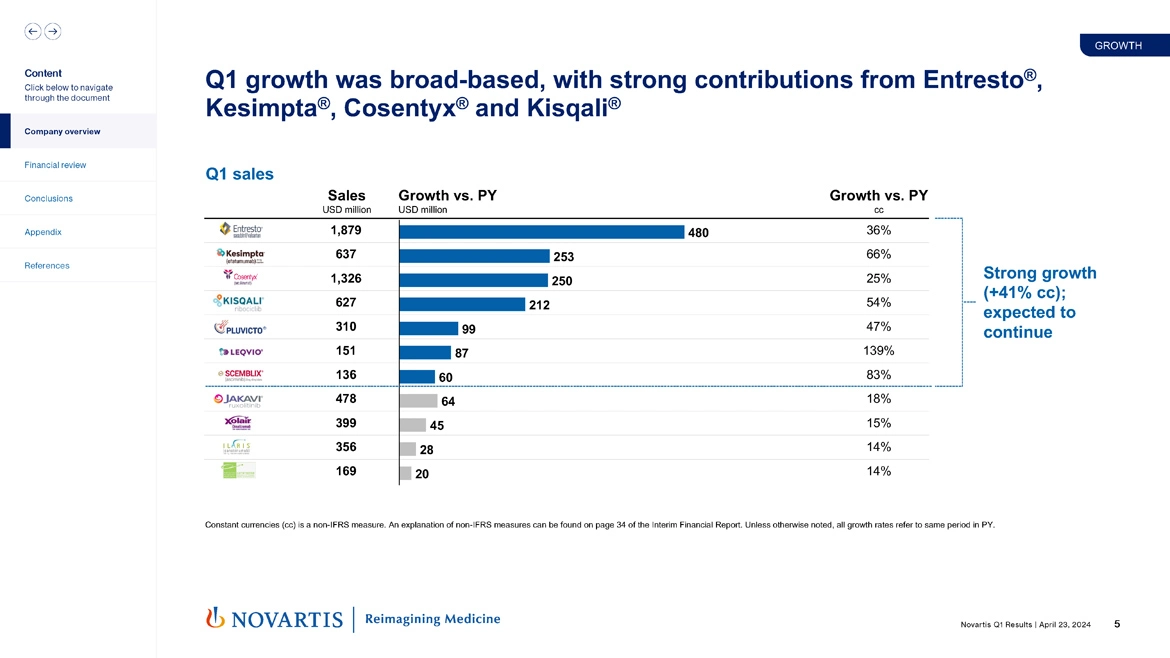
Now moving to Slide 5. Now our growth in the quarter was broad-based, and we had strong contributions from many of our key growth drivers, including Entresto®, Kesimpta®, Cosentyx®, which had a very strong quarter as well as Kisqali®. I would also say geographically, our performance was broad-based with strong growth across US, Europe, China with very strong growth and Japan.
As you can see on the chart, the strong growth was indicated by 41% constant currency growth, and we expect this growth to continue over the course of the year, which is what gives us confidence to do the upgraded guidance that we've outlined this morning.
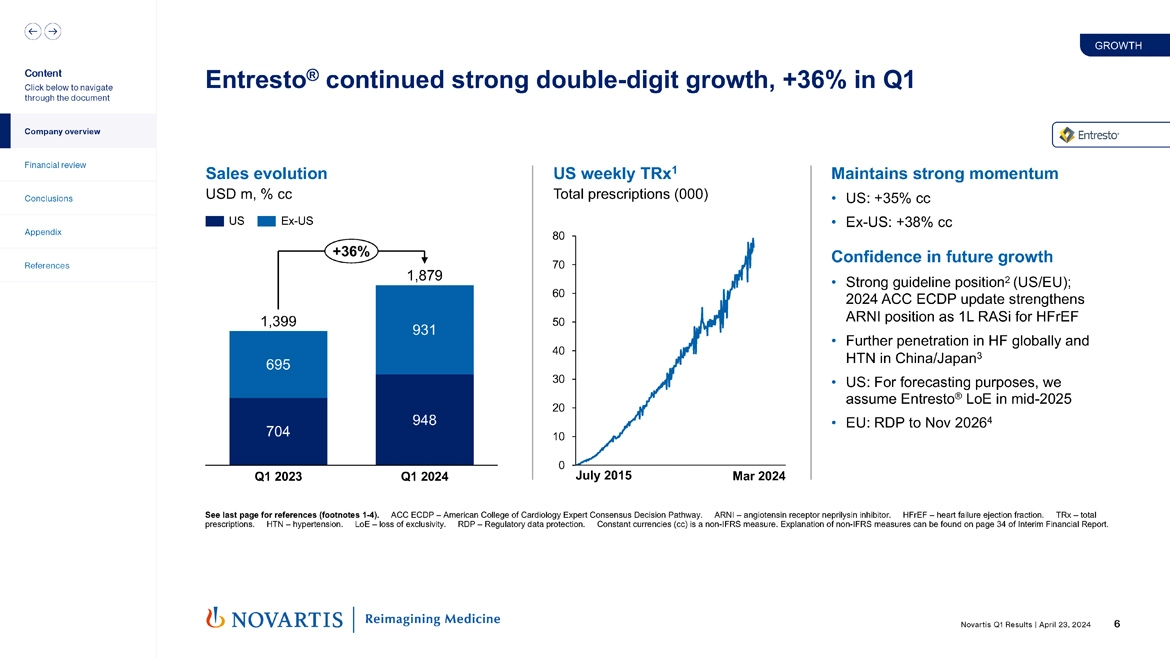
Now moving to Slide 6, and we'll walk through the brands one by one as we always do. First, with Entresto®, we had double-digit growth, up 36% in quarter 1. That was, again, geographically broad-based, US and ex-US In the US, our weekly TRx continue to reach new highs. We had 38% constant currency growth outside of the US. And we continue to see momentum for this brand. We're in a strong guideline position both in the US and in Europe. We have further penetration opportunities in heart failure globally and specifically in hypertension in China, in Japan and in Japan, we have protection into the early 2030s with this medicine.
For forecasting purposes, no change in our Entresto® LoE outlook, continue to guide to a mid-2025 LoE while continuing to aggressively defend our various patents. And then in terms of the EU, we continue to guide to RDP in November 2026 benefiting from our pediatric extension.
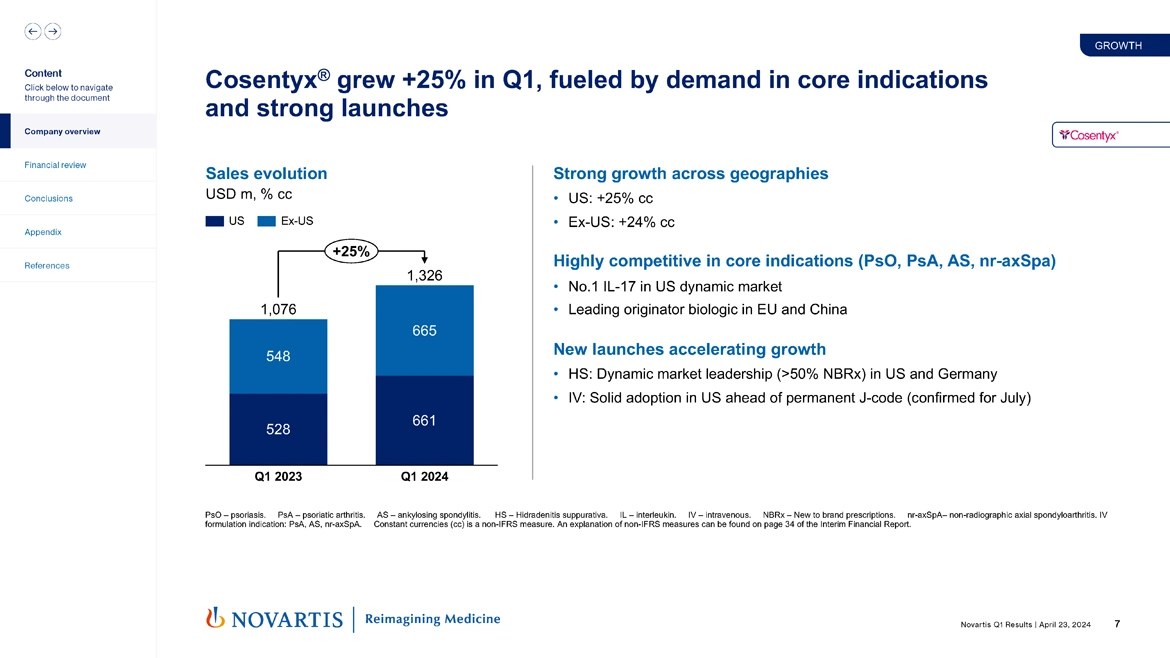
Now moving to Slide 7. Cosentyx® grew 25% in the quarter, and I think really got back to the dynamic growth we expect for this medicine. This was fueled both by our core indications, but also some strong launches, and I'll go through that in a bit more detail. US was up 25% in constant currency, ex-US, 24%. We had highly – we're highly competitive in our core indications. And so we saw a return to market share improvement in psoriasis and in the rheumatology indications both in the US and in Europe. And we're now the leading originator biologic in the IL-17 class in EU and China.
Now in terms of our new launches, we saw very strong performance in HS, hidradenitis suppurativa, where we have over 50% now NBRx share versus adalimumab in US and Germany. When we compare our launch on a comparable basis to the adalimumab launch in this indication, we currently see ourselves at nearly 3x the performance of that previous launch. I think really highlighting how strong the uptake for Cosentyx® has been in this new indication.
We also had very strong performance in the intravenous indication ahead of the J-code, which we expect in July. I think, again, that indicates there is strong interest in having an IV option for patients with Cosentyx® in the rheumatology indications. So we'll look forward to further acceleration in the back half of the year once we have that J-code in place.
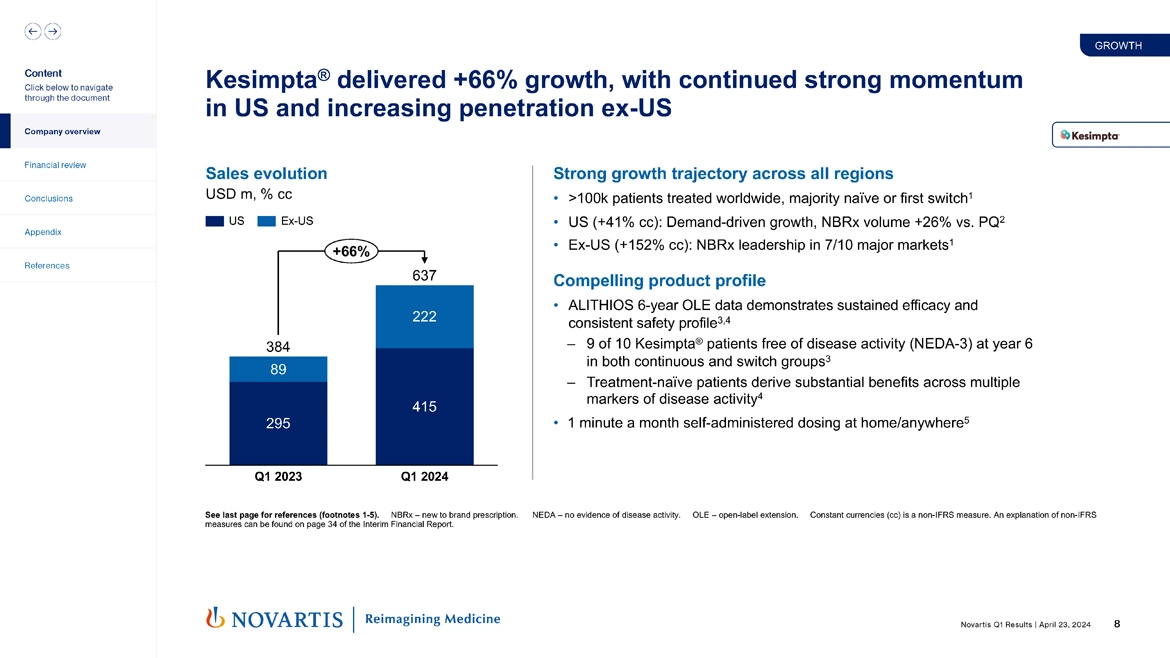
Now moving to Slide 8. Kesimpta® delivered 66% growth on the quarter, and this was again global US and ex-US driven. We have over 100,000 patients treated worldwide on the medicine, and the majority of these patients are either naive or first switch, which reflects the strategy we have for this brand.
In the US, we saw a very strong demand-driven growth with NBRx volume at plus 26% versus prior quarter. And one of our key priorities now in the US is to increase our B-cell market share over the coming quarters. Outside of the US, we have leadership now in seven out of ten major markets, and we look forward to continuing to drive the convenience and high efficacy story that Kesimpta® presents in these markets.
In the quarter as well, we announced the ALITHIOS 6-year long-term data, which demonstrated sustained efficacy and the consistent safety profile for Kesimpta®. In this study, nine out of ten patients were free on the NEDA-3 score of disease activity. And we also saw treatment-naive patients derive substantial benefits across multiple markers of disease activity. So even in the face of some competitor launches, we feel very confident about the one minute a month self-administered dosing, high efficacy, strong safety profile of Kesimpta®.
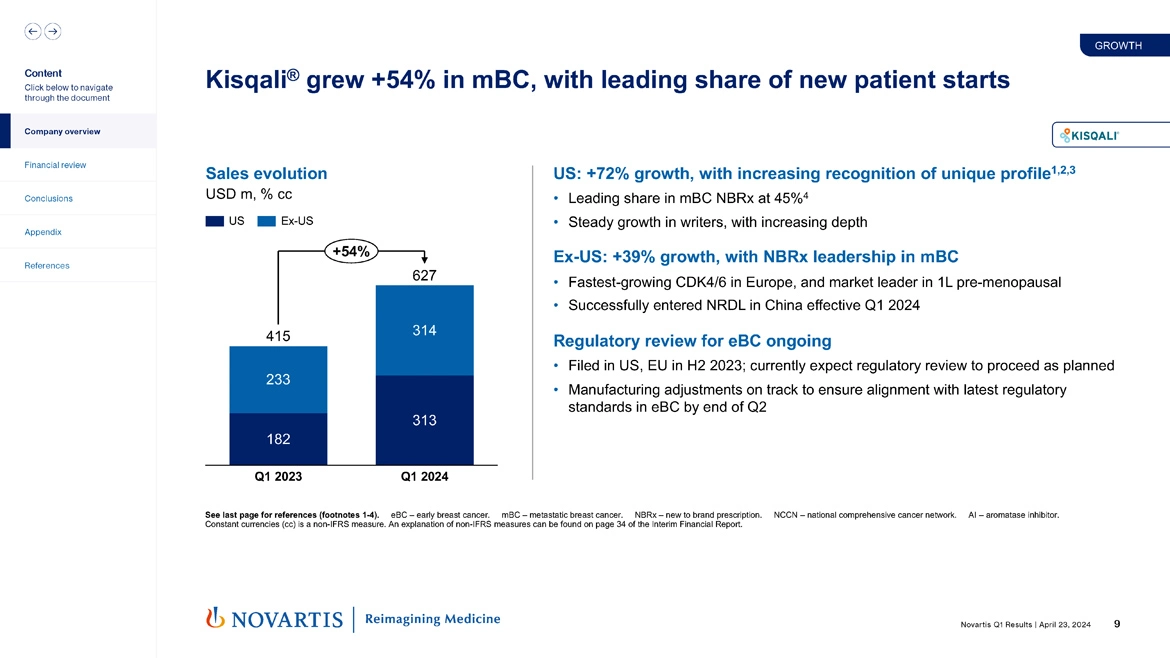
Now moving to Slide 9. Kisqali® grew 54% in metastatic breast cancer with now continued leading share in new patient starts. US was up 72%. And I think there's increasing recognition of the unique profile that Kisqali® offers given its broad data set of OS across three different studies in metastatic breast cancer. We have leading NBRx share at 45%. And we see a steady growth in writers. We're also working to increase depth as well as improve our market access position across key accounts ahead of the early breast cancer launch.
Now outside of the United States, 39% growth. We're the fastest-growing CDK4/6 in Europe and a market leader in the pre-menopausal indication. We also successfully entered the NRDL list in China in quarter 1, and it's early days in China, but given the strength of our China operations, we're hopeful we can draw dynamic growth for Kisqali® in China over time. The regulatory review in early breast cancer is ongoing. We're filed in the US and EU and currently expect regulatory review to proceed as planned.
Our manufacturing adjustments, which we disclosed a few weeks ago are on track to ensure alignment with the latest regulatory standards in early breast cancer by the end of Q2, and we continue to expect to be able to launch this medicine in the second half of this year.
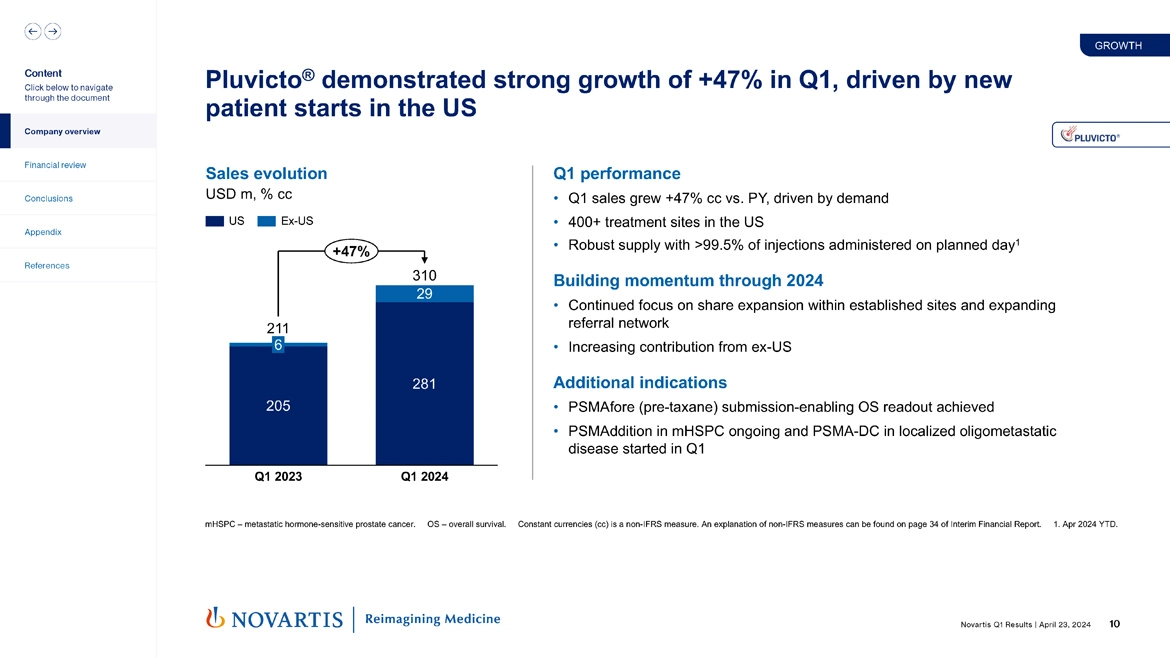
Now moving to Slide 10. Pluvicto® had strong growth of 47% in the quarter, driven by new patient starts and very early beginnings of growth as well outside of the US. We have 400 treatment sites now up and running in the US, on a steady progress to our goal to get well over 500 sites fully certified for the use of Pluvicto®. Also, our supply performance is now consistently at a very high level with over 99.5% of injections administered on the planned day. So ample supply, Indianapolis facility up and running, continued expansion of our manufacturing network. So we really feel like we're now in a position to fully supply the market consistently globally for this medicine.
Now over the course of 2024, we're going to focus on share expansion within existing sites and particularly expanding the referral network of medical oncologists who can refer into a Pluvicto®-treating center, we feel like this will be the key now in the post-taxane setting. We also want to build our business outside of the United States with some important launches in Europe as we also build towards launches – planned launches in Japan and China, both countries where we have planned new manufacturing facilities to support the Pluvicto® and Lutathera business.
Our existing indications are also on track. We announced earlier this quarter that the PSMAfore submission-enabling OS readout was achieved. And this will put us in a position to file Pluvicto® early in the second half, so a midyear filing for this medicine. And then PSMAddition also on track as well as the PSMA delayed castration localized oligometastatic program as well.
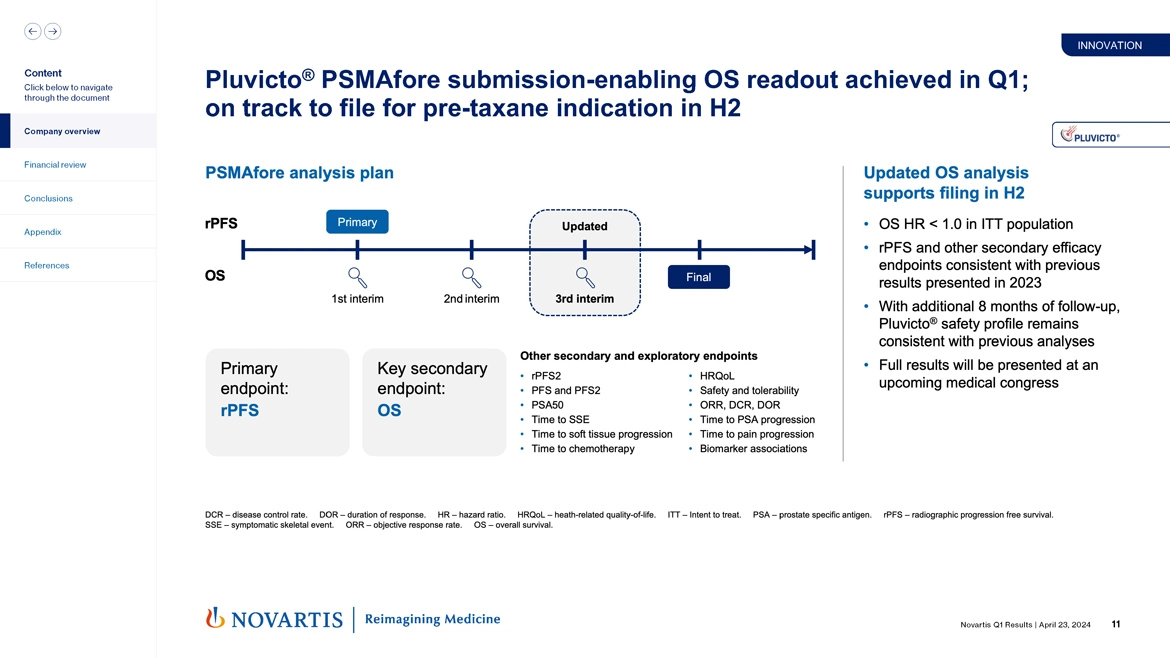
Now a little more detail on the PSMAfore submission-enabling OS readout. We had a primary endpoint that we read out last year where we met the primary endpoints as well as really strong data across all of the secondary and exploratory endpoints, a very impressive relative risk reduction for rPFS, strong profile across the patient-reported outcomes as well as the various response, ORR, DCR, and DOR. What we announced earlier in the quarter was the updated third interim, which gave us a higher proportion of OS events. The OS hazard ratio was less than 1, which puts us in a position to file midyear.
And other secondary endpoints were consistent with the previous results as was the rPFS. And what we feel and see is with the additional eight months of follow-up, we have high confidence in the safety profile of Pluvicto®. And so these results will be presented at an upcoming medical congress. And of course, we're working as quickly as we can to get this filed in.
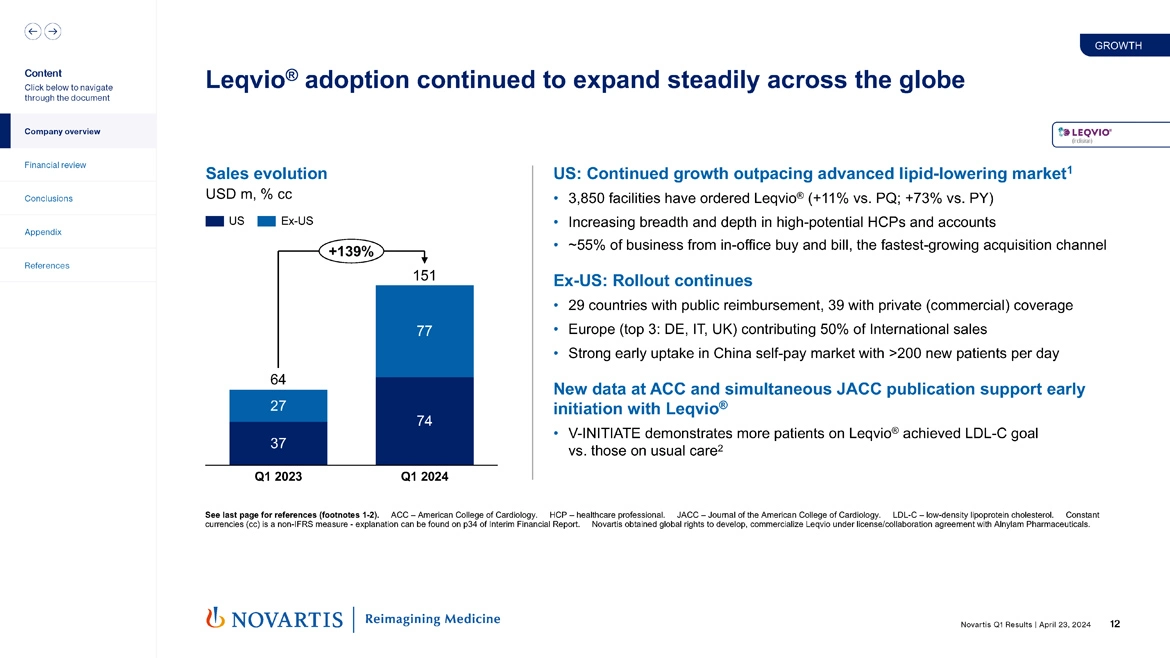
Now moving to Slide 12. Leqvio® also had a really strong quarter. Adoption expanded steadily in the US, but also outside of the United States, as you can see here, on the left-hand chart, very strong performance, both in the US and outside the US. Taking the US first, we had growth outpacing the advanced lipid-lowering market. We have now nearly 3,900 facilities that are ordering Leqvio®, increased breadth and depth across our key accounts. We continue to see buy and bill as the key driver overall of the business. But we do see also the use of other channels as well.
Outside of the US, we have a consistent rollout. Now we have 29 countries where Leqvio® is publicly reimbursed and an additional 39 with private commercial coverage. This puts us in a strong position with our top three European markets contributing 50% of international sales, but really strong growth across the international region. And strong early uptake in China in the self-pay setting with over 200 new patients a day ahead of our planned NRDL listing in the first part of next year.
Lastly, we had new data at ACC and a publication as well, which supported the early initiation of Leqvio®, demonstrating that starting Leqvio® early in patients requiring secondary prevention for a cardiovascular event, a lot of these patients do achieve their LDL-C goals earlier.
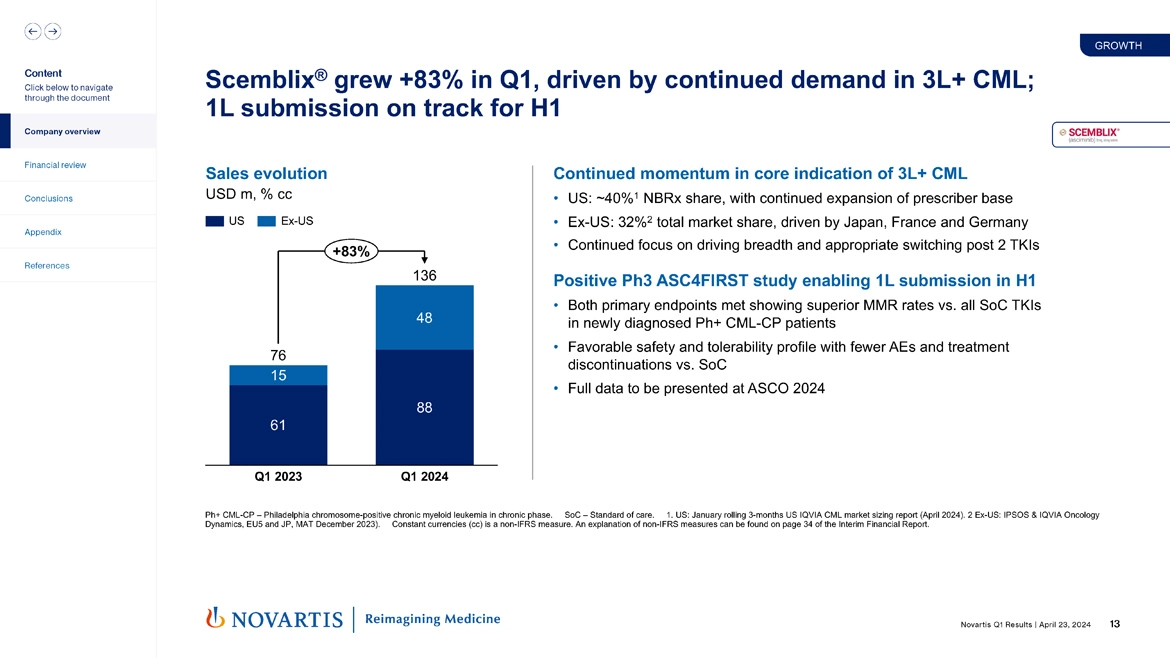
Now moving to the next slide. Scemblix®, grew 83% in the quarter again, primarily driven by the third-line indication with our first-line submission on track to be completed in the coming months. We had continued momentum in the core third-line indication, over 40% NBRx share. Outside of the US, we're at a 32% total market share driven by our key markets, Japan, France and Germany. And here in the third-line setting, we primarily focus on early identification of patients who could benefit from a switch to Scemblix® post two TKIs.
As a reminder, our ASC4FIRST study enabled first-in-line submission – first-line submission in half 1. Primary endpoints were met versus all standard of care TKIs and versus Gleevec® as well, favorable safety and tolerability profile, and we can confirm that the full data will be presented at ASCO in 2024.
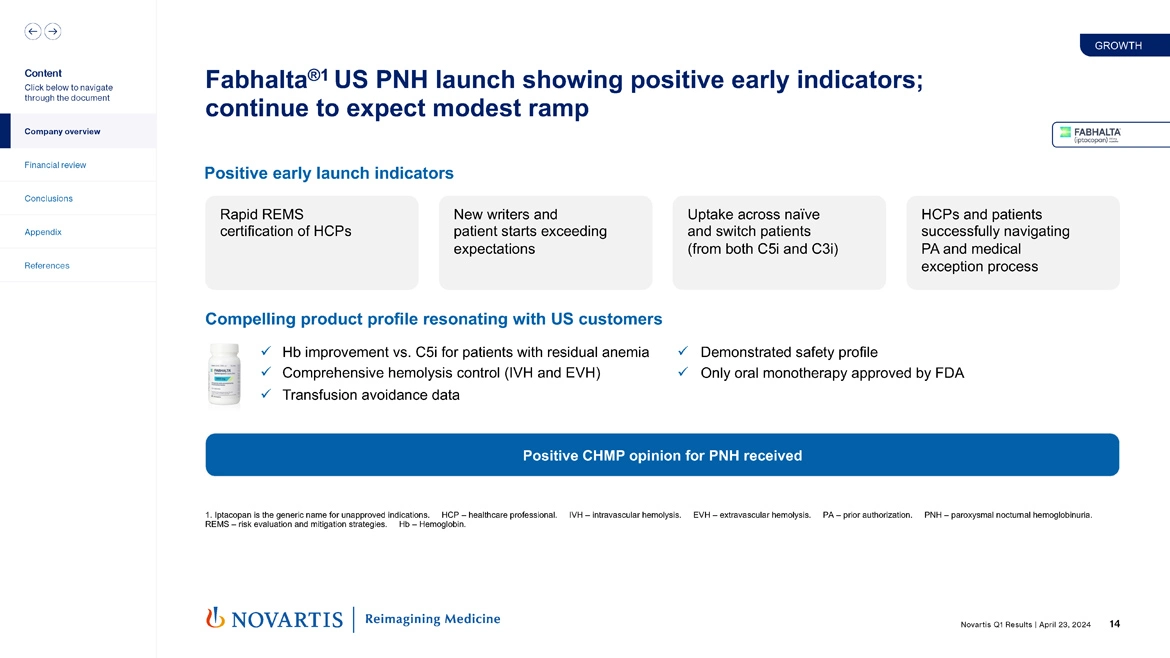
Now turning to Fabhalta®. We're at the early stages of the PNH launch, and we didn't expect really to see significant sales at this very early stage, given the complexity of this launch. But we are very pleased with the early launch indicators, we've had a rapid increase in the number of HCPs who are certified under the REMS program, an increase in new writers and patient starts, which are exceeding our internal expectations, we see uptake across naive and switch patients for this medicine.
And we also are really happy to see HCPs willing to work through the medical exception process to get patients on this medicine. So we've also have the positive CHMP opinion for PNH, and we expect that full approval to happen in the coming few months. And we'll consistently work to launch this medicine across the globe as well as drive rapid uptake in the United States.
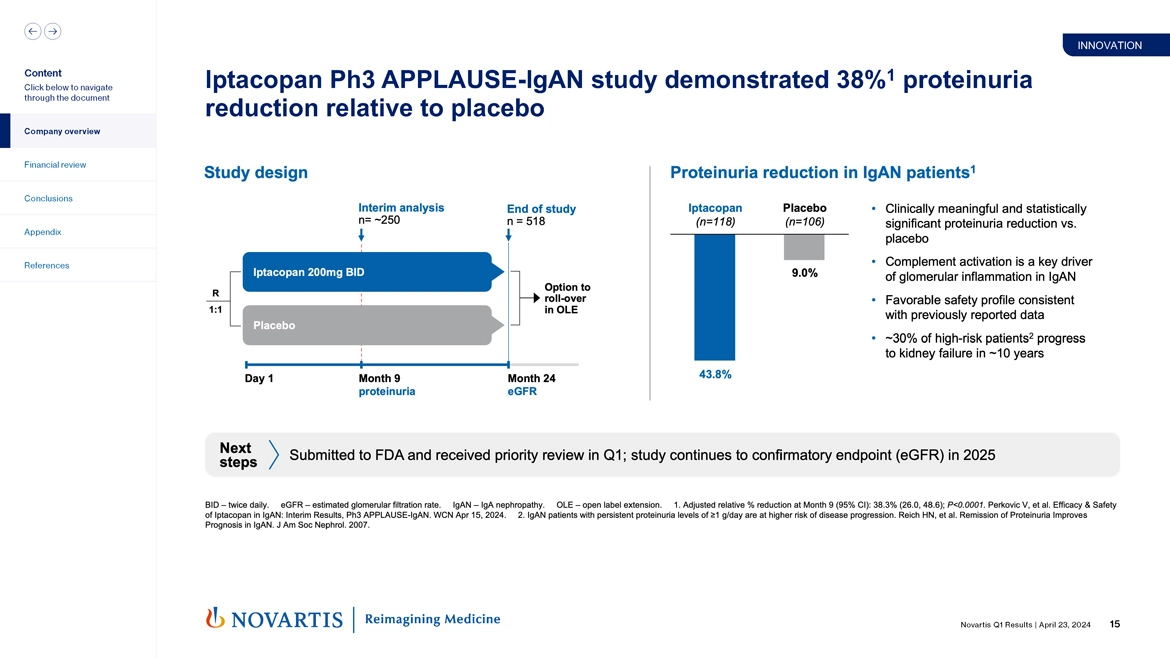
Now turning to Slide 15. We also announced our Phase III APPLAUSE-IgAN study, full results earlier in the quarter, where we demonstrated 38% proteinuria reduction relative to placebo. In this study, we randomized patients to iptacopan versus placebo. The results we read out was the 9-month interim proteinuria analysis. These patients will be – continue to be followed out to month 24 for the full eGFR analysis.
You can see on the right-hand panel, very impressive proteinuria reduction of 43.8% versus placebo at 9%, clinically meaningful and statistically significant. We know that complement activation is a key driver of inflammation in IgAN. And importantly, the overall safety profile was consistent with data we've previously reported. We've submitted this data to FDA. And just one clarification, we did not use a priority review voucher for this medicine. The FDA granted us priority review based on the data set that we provided. So this study continues as well for its eGFR readout in 2025, and we look forward to really getting a full approval very shortly – or getting the initial approval in the coming period.
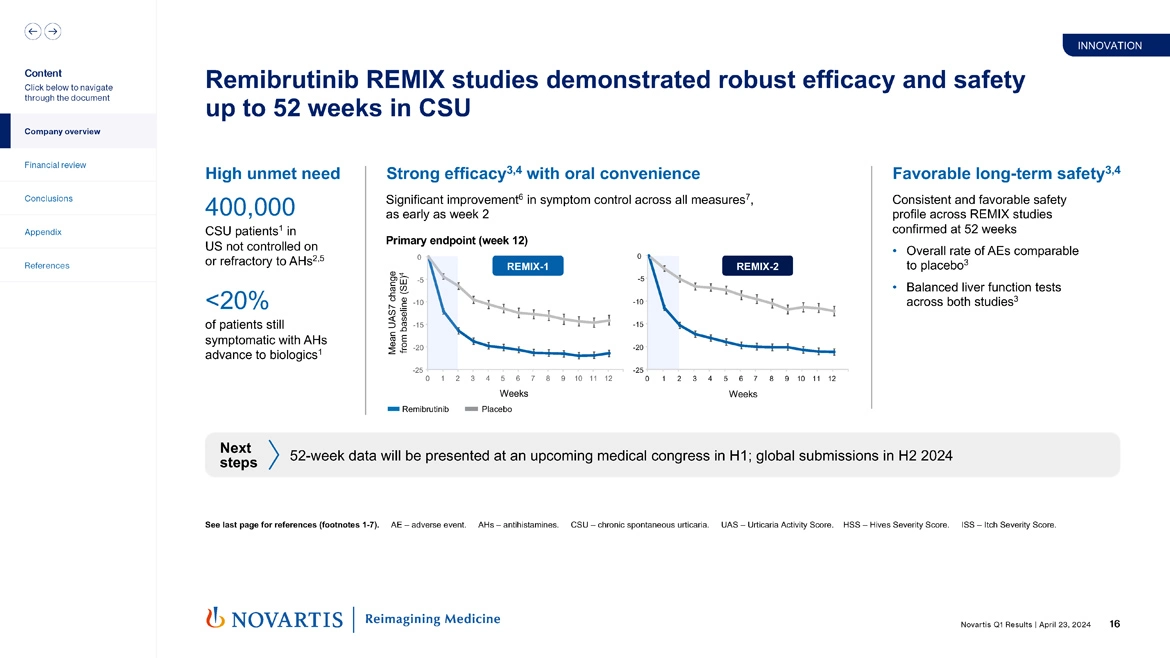
Moving to Slide 16. Now remibrutinib demonstrated – had already demonstrated in an earlier study at 12 weeks, robust efficacy and safety. But we needed to wait for the 52-week data to be in a position to file in chronic spontaneous urticaria. And this data came out positive, enabling us now to move forward toward this important filing.
As a reminder, there's about 400,000 CSU patients in the US not controlled or refractory to antihistamines. And only less than 20% of these patients are currently on biologics. So there's a large opportunity for a high-efficacy oral medicine. The previous primary endpoint data at week 12 as shown here, where we very consistently showed improvements versus placebo at the week 12 on the UAS7 score. And so we'll look forward to presenting the full data set in the second quarter for this medicine out to 52 weeks. And with the consistent favorable safety profile we've demonstrated with overall rates of AE comparable to placebo and balanced liver function test as well as the clear efficacy data, we'll look forward to global submissions in the second half of remibrutinib.
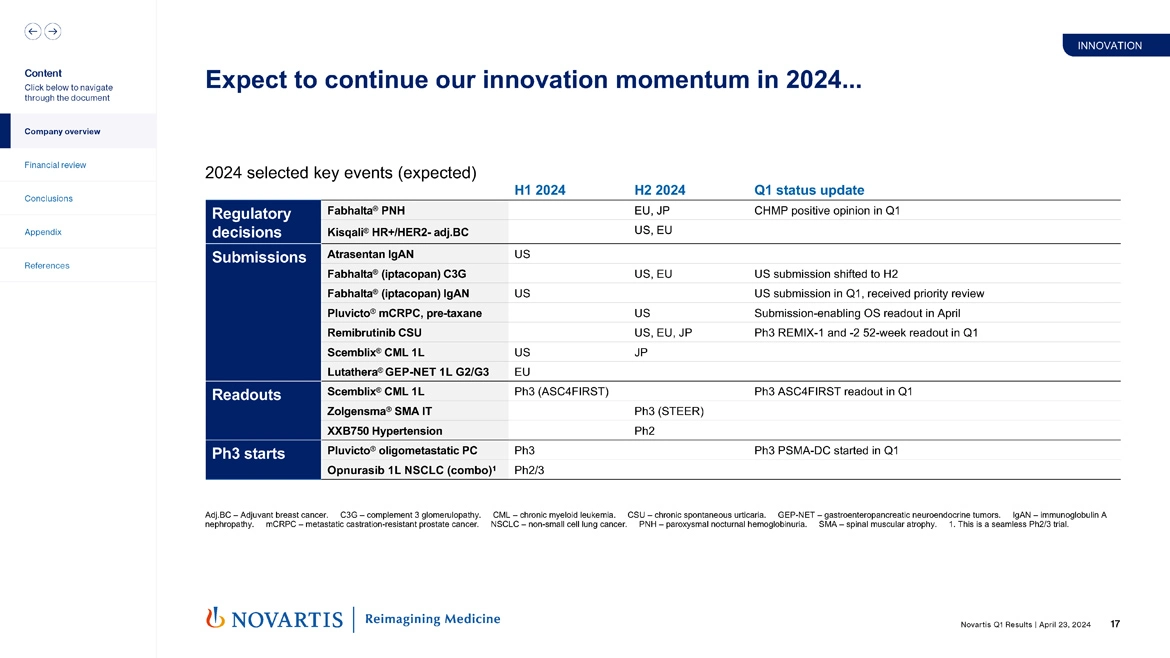
So all taken together, we're on track across our innovation goals for the year. I did want to highlight that we have shifted our iptacopan C3G US submission to the second half. There is no great correlate for efficacy in C3G, given the ultra-rare nature of this disease. We provided the FDA our 6-month data. While certainly, we believe that 6-month data was very compelling. The FDA wanted to see the additional 6-month follow-up for these patients after all patients had rolled over on to active. The first 6-month period was randomized, second 6-month period, all patients are on active. So we will complete that 6-month follow-up and then file in the second half. And we remain very excited about the opportunity to bring Fabhalta® as well to patients with C3G.
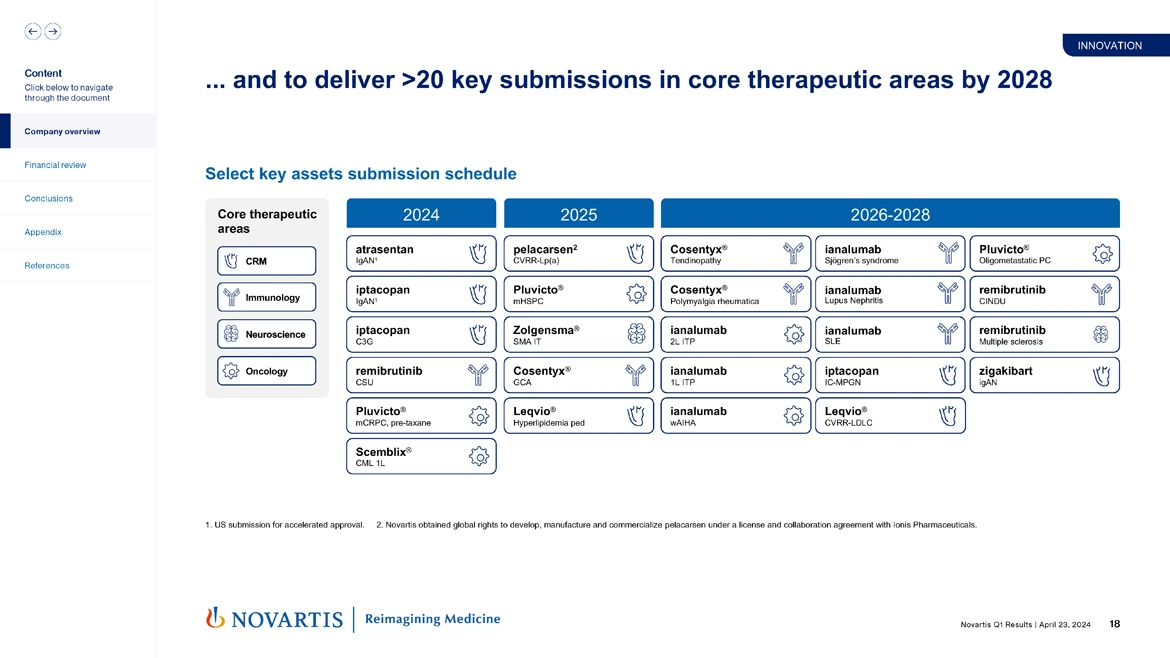
So moving to the next slide. We also are on track for our range of submissions, '24, '25 and '26 to '28. So we'll continue to keep you abreast of how data sets unfold as well as potential readout timelines as we understand those readout timelines better and really excited about the catalyst-rich profile that we have out – through the coming years. So moving to Slide 19, I'll hand it over to Harry.
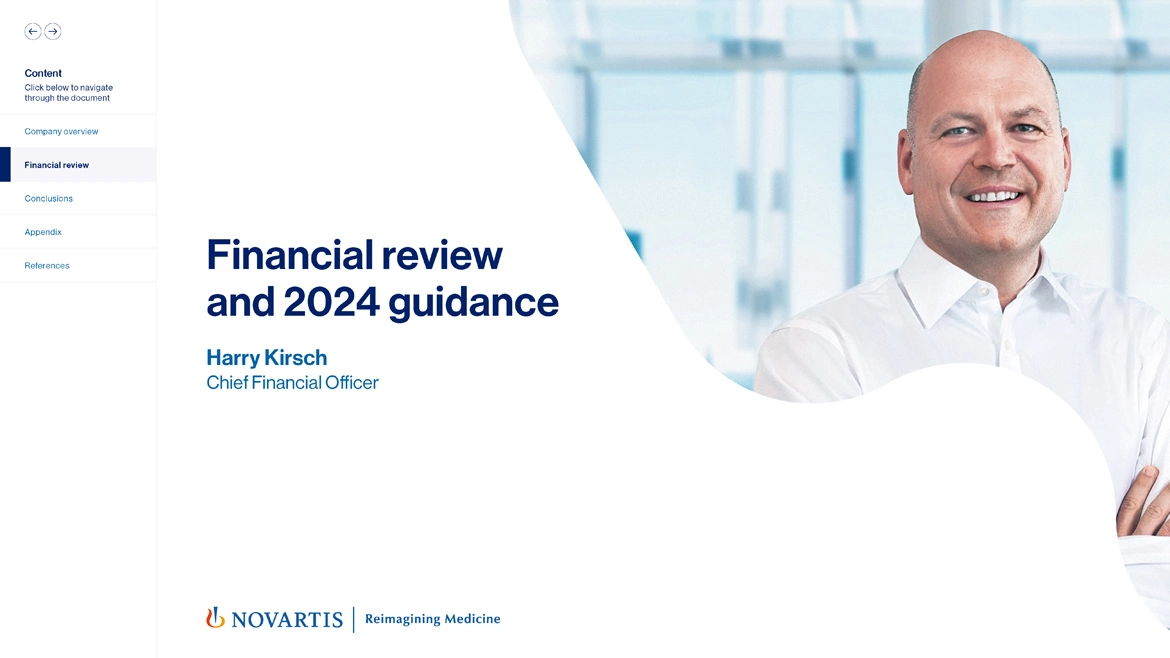
Yes. Thank you very much, Vas. Good morning, good afternoon, everyone. I'm now going to walk you through some of the financials for the first quarter. And as always, my comments refer to growth rates in constant currencies unless otherwise noted. Also, throughout the presentation, I refer to continuing operations. And as you see from the numbers, it has been a very strong start to the year.
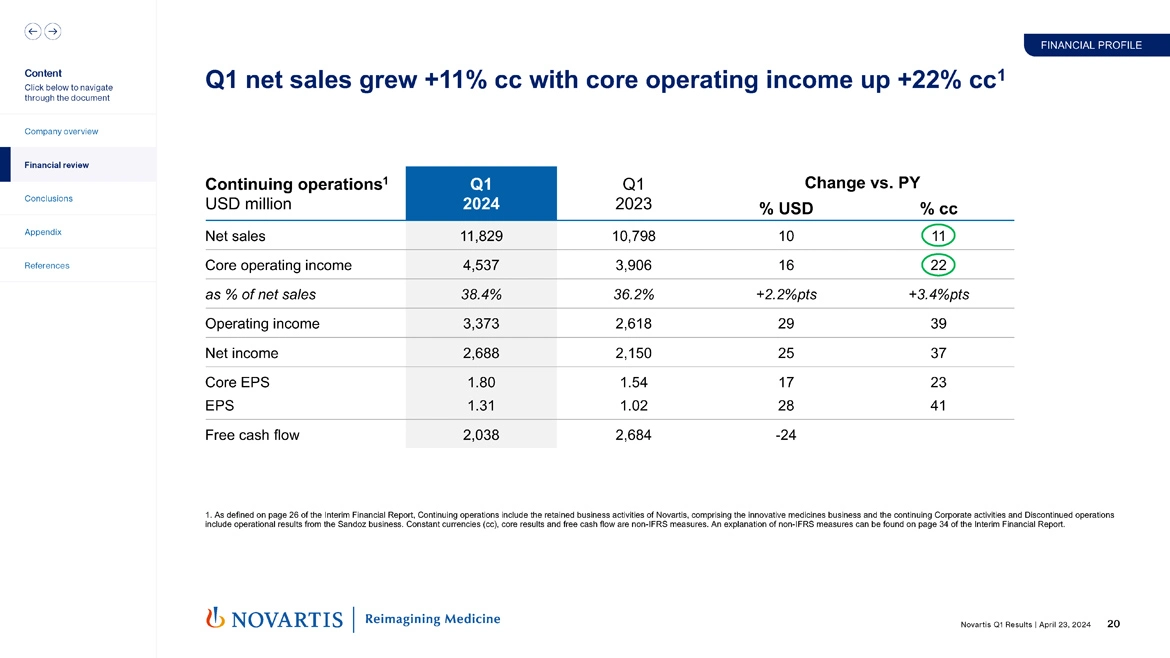
So on Slide 20, you see a summary of our financial performance with net sales up 11% and core operating income up 22%. Our core margin grew 340 basis points to reach 38.4%, showing that we are very well on track to achieve our midterm margin guidance of 40% plus by 2027. Core EPS was USD 1.80 for the first quarter, growing 23%, a bit ahead of core opinc due to the share buyback program. Free cash flow was USD 2 billion, declining versus quarter 1 of 2023, but that was due to a prior year one-timer and the timing of some tax payments this year. However, and importantly, for the full year 2024, free cash flow is expected to grow approximately in line with core operating income. So in summary, very strong start to the year as our efforts to focus and streamline the business continue to pay off.
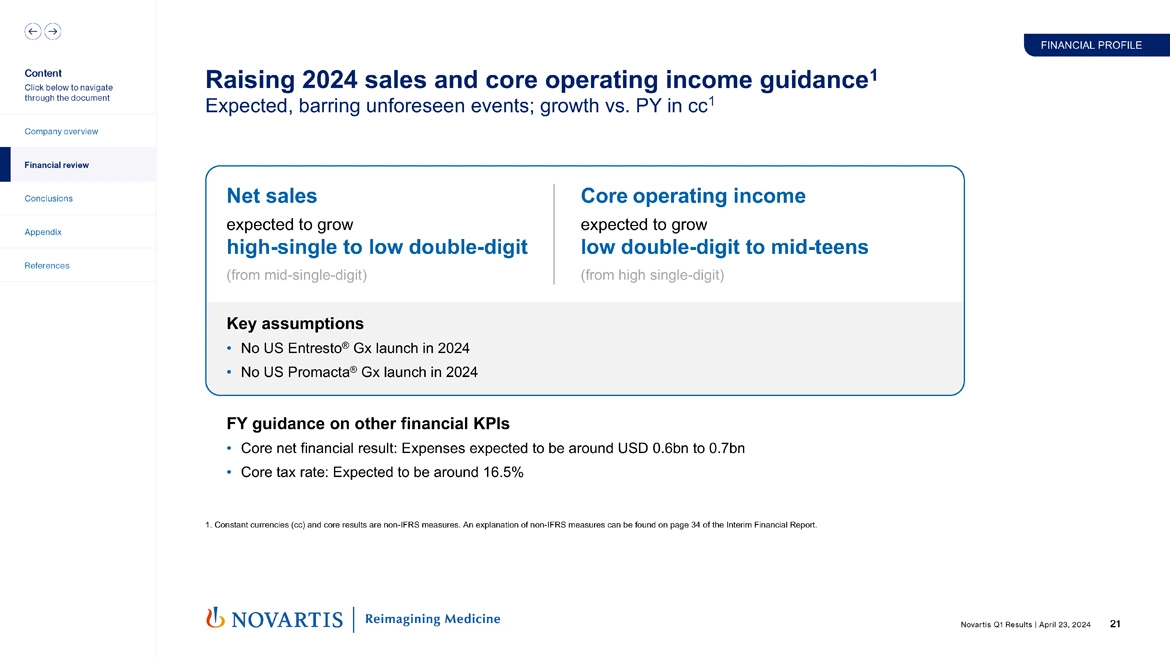
This brings us already to our full year guidance on Slide 21. So the strong momentum in our business across our in-market growth brands and launches, both in the US and international markets give us the confidence to upgrade both top and bottom-line guidance. We have also a favorable update on generic entry assumptions in US, but that's actually a smaller element of the analysis driving our 2024 guidance upgrade. We now expect net sales to grow in the range of high single-digit to low double-digit and core operating income to grow in the range of low double-digit to mid-teens.
Underpinning our guidance are two key assumptions that no Entresto® and no Promacta® generics will launch in 2024 in US. And to complete our '24 full year guidance, please know that we continue to expect core net financial expenses to be in the range of USD 0.6 billion to USD 0.7 billion. Our core tax rate to be around 16.5%.
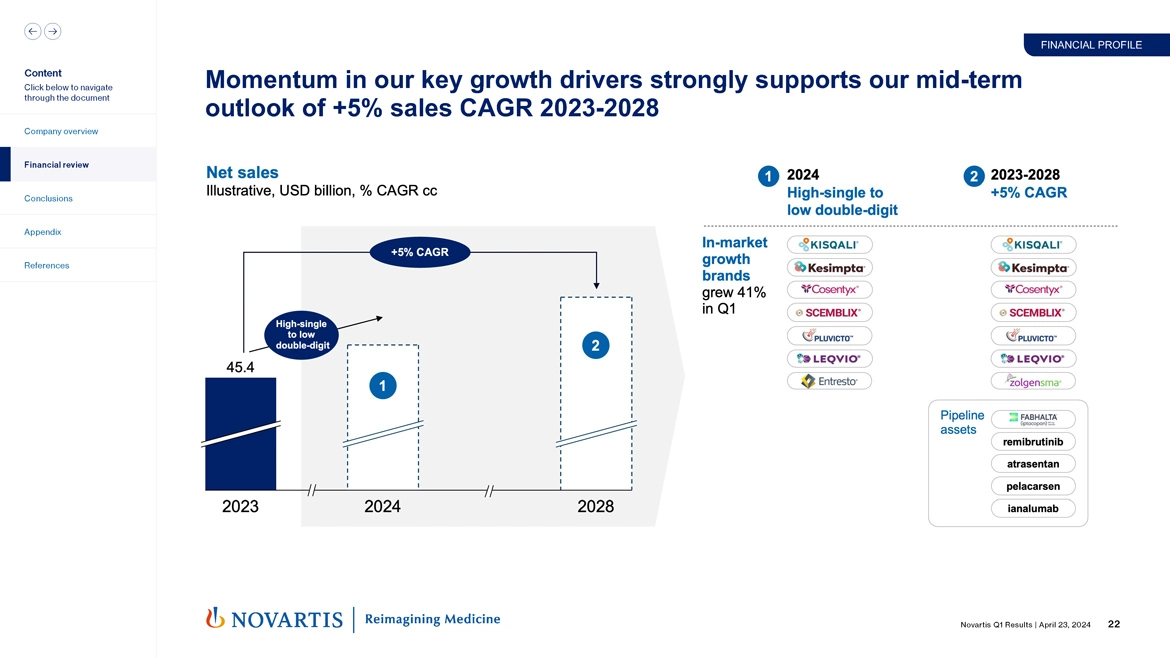
Now moving to Slide 22. I'm very pleased with the quality of our quarter 1 sales growth driven by our key in-market brands, which grew as Vas showed also on the prior slide, 41% in the quarter. And the vast majority of these brands still have many years of patent protection ahead of them. So their continued momentum strongly supports our midterm growth outlook of 5% CAGR through 2028.
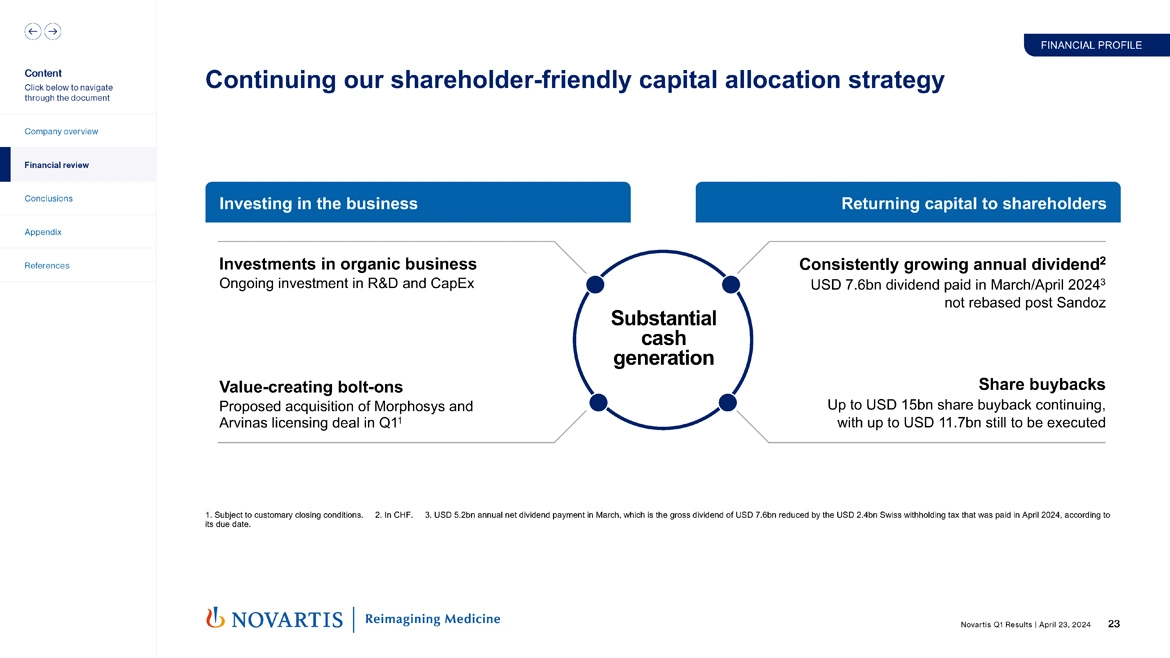
Slide 23, please. Just to highlight that we continue our shareholder-friendly capital allocation strategy in quarter 1, of course, investing in the business alongside returning capital to shareholders. Notably, in Q1, we announced two value-creating bolt-ons in our core therapeutic areas, the proposed acquisition of MorphoSys and the licensing deal of Arvinas, both of which align with our strategic focus in oncology. In terms of returning capital to our shareholders, we paid USD 7.6 billion of our growing dividend in quarter 1. And we also continue our up to USD 15 billion share buyback program and we still have USD 11.7 billion remaining to be executed by the end of 2025.
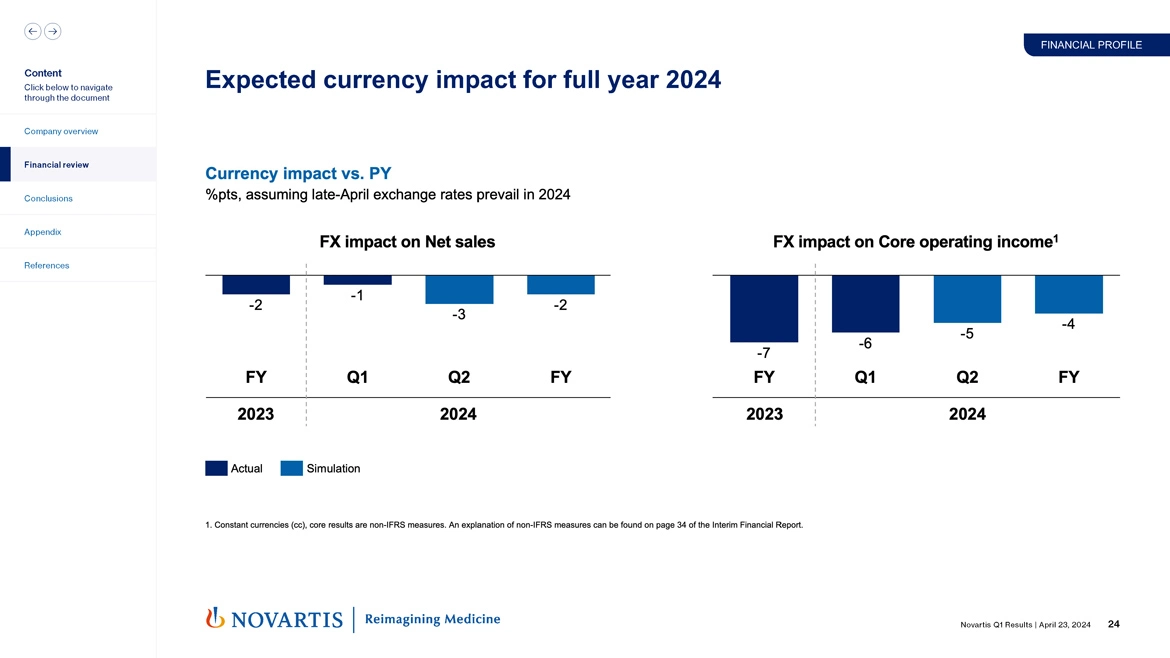
Already to my final slide, 24, we have outlined some of the details regarding the FX impact. And as you see, in quarter 1, FX had a 1% negative impact on sales and 6 points negative on core operating income, the latter driven by the strong Swiss francs. And if late-April rates prevail, including the most recent strengthening of the US dollar, we expect the full year impact of currency still to be less than it was in '23 on a top line negative 2%, bottom line, a negative 4%. As a reminder, as this is hard to forecast from the outside and moving all the time, we are updating our – the expected FX impact on our website on a monthly basis. And with that, I hand back to Vas.
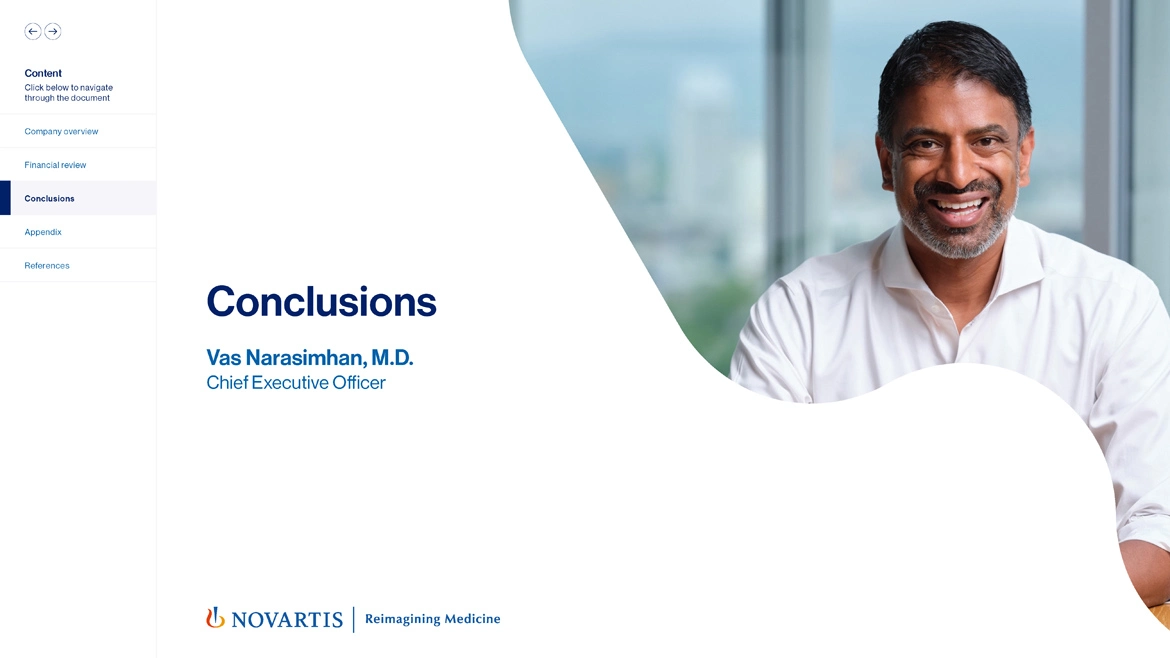
Great. Thanks, Harry.
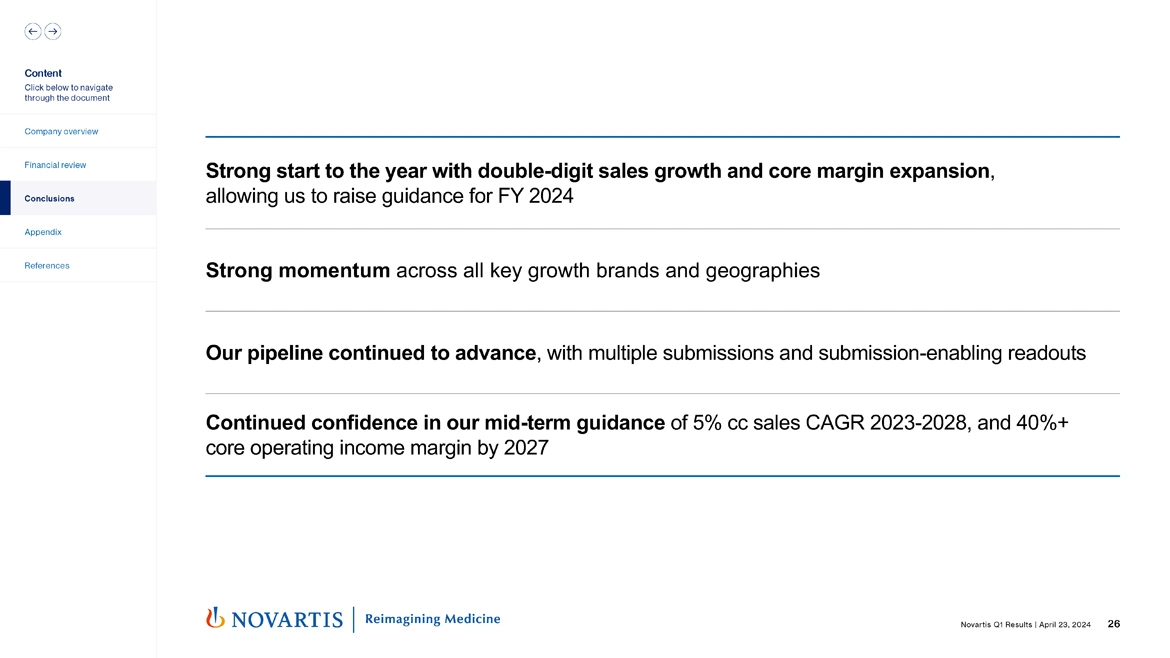
So as you heard, a strong start to the year with double-digit sales growth, strong core margin expansion. And with the strong momentum we see in the business, we're able to raise our guidance for the year. We saw this momentum across all of our key growth brands and across geographies, I think, indicating the high quality of the performance that we're seeing in the company.
Our pipeline continues to advance with multiple submissions and submission-enabling readouts as we outlined. And we continue to have confidence in our midterm guidance of 5% constant currency sales growth, '23 to '28, and 40% plus core operating income margin by 2027. So with that, I'll hand it back to Sloan, who will outline some of our upcoming investor events.
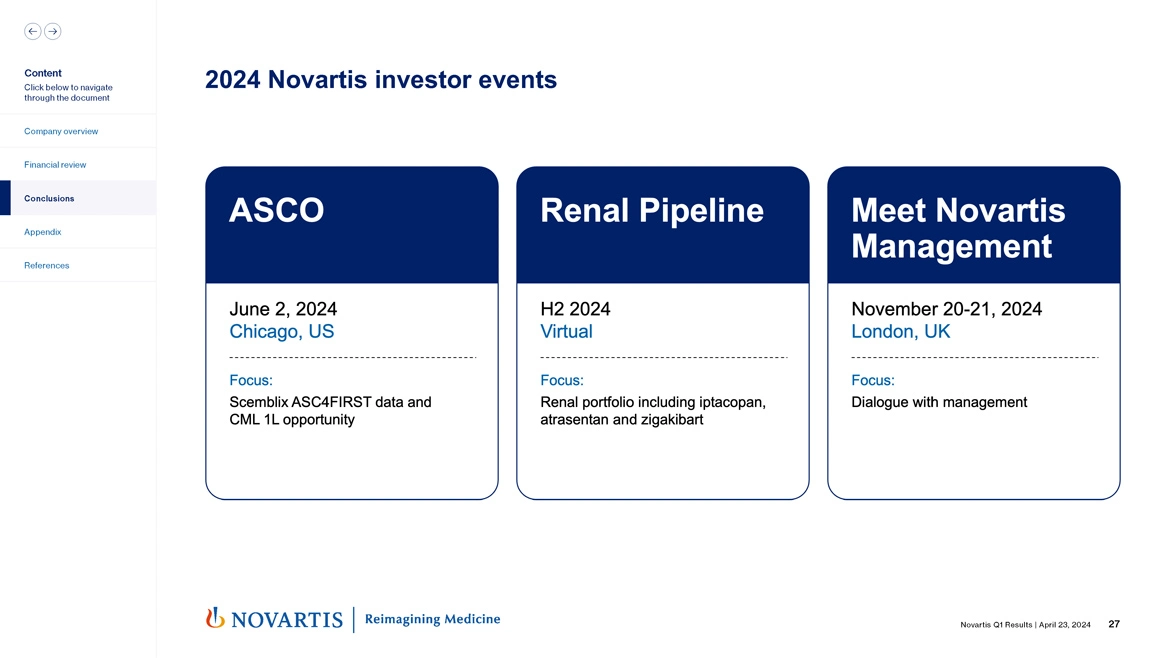
Thank you, Vas. Before we open up for questions, I just wanted to flag a few investor events that we're planning to hold this year. First, we'll have an in-person event at ASCO in Chicago on June 2, highlighting Scemblix® ASC4FIRST data, which Vas mentioned. We'll also have a virtual event on our renal pipeline in the second half of the year. and we'll be having our annual Meet Novartis Management event in London on November 20 to 21. We hope to see many of you at these events. And with that, operator, let's open the line for questions, please.
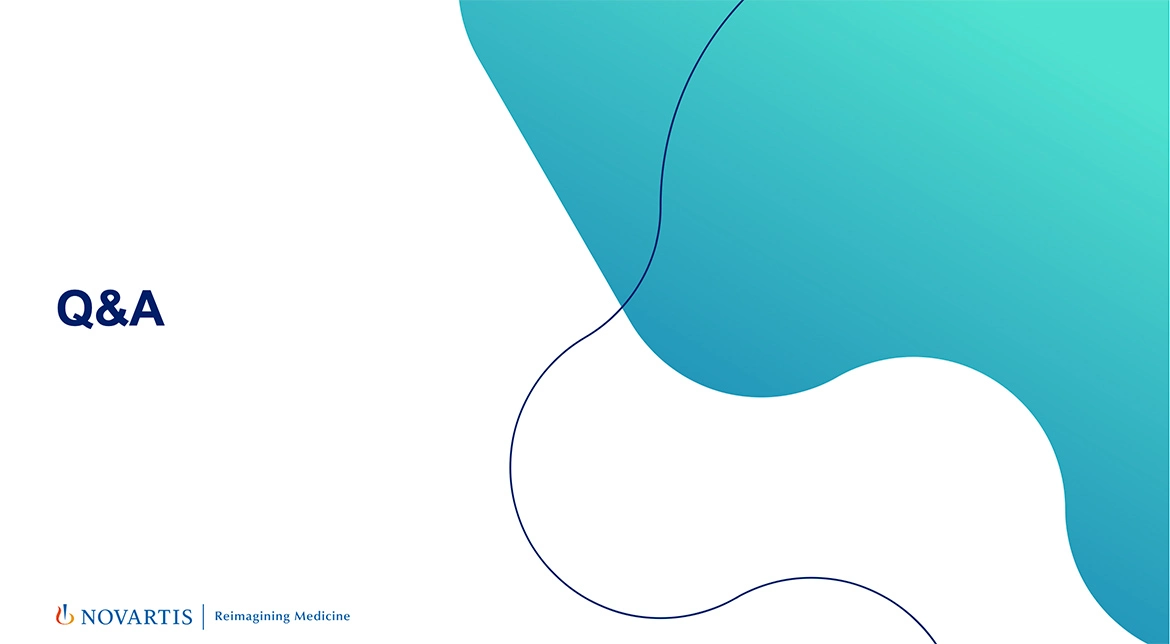
(Operator Instructions) And your first question comes from the line of Matthew Weston, UBS.
Q. It's going to be on Pluvicto®. And so Vas, you set out some of the metrics in terms of improving revenue. I think there's definitely an expectation amongst investors that we might see an inflection as supply comes online and physicians get more comfortable with your ability to supply and add nurses and chairs into their networks. I wanted to understand whether you thought that was a realistic assumption or whether or not investors should get more comfortable with a kind of continuous grind in the growth of Pluvicto® over the coming quarters?
A. Yes. Thanks, Matthew. So first, on Pluvicto®, we have resolved our supply issue, but we are still working through, I think, the remnants of the base of patients that were a bit lower in quarter 4, given that we were still working through things then. And when you think about the growth of Pluvicto® medium-to-long term, first, we have this post-taxane indication, where you can see we're already annualizing at a pretty healthy blockbuster, USD 1 billion-plus sales range.
And we expect that to steadily grow, and we guided to that indication to being a multibillion dollar, so a USD 2 billion-plus indication. So we expect it to steadily grow over the coming quarters in that post-taxane setting. And this will be primarily driven by, as I mentioned, expanding the base of medical oncologists who are able to refer into the existing centers. We don't see the opportunity at this point in terms of expanding the number of centers for this indication.
So that will steadily grow over the course of 2024 to get us steadily marching up towards that multibillion-dollar guidance, USD 2 billion-plus guidance that we've given in the VISION indication. Then we expect the PSMAfore pre-taxane indication to be the next catalyst, and we do expect an inflection on that launch which will then – I should also mention in Pluvicto® outside of the US as well, we will get additional momentum as we bring on board Germany, France, other countries in Europe. And then in the coming years, we do expect a substantial inflection from China and Japan. We're building dedicated manufacturing facilities for those countries in order to drive further growth, both in the pre-taxane and the post-taxane indication.
Next catalyst will be the pre-taxane approval, which we hope to have in the first half of next year. Then the hormone-sensitive indication than the oligometastatic. And then we also have two programs advancing with actinium PSMA as well to also further bolster the overall portfolio. So I think a steady growth in the VISION indication within catalysts coming from ex-US expansion and the indication expansions for the brand.
Your next question comes from the line of Steve Scala from TD Cowen.
Q. Vas, you noted in the prepared remarks that the Kisqali® review was on track, but how confident is Novartis that FDA will meet the priority review regulatory deadline for Kisqali® with a broad label? There seems to be a number of things that could give FDA pause, including the nitrosamine issue as well as liver tox. So what is your level of confidence?
A. Yes, Steve, we're very confident on the broad label. I think on the timeline, we currently guide to the current timeline that we have as we implement these manufacturing shifts. We of course, are discussing these manufacturing adjustments and they're minor adjustments, but they do require discussions with FDA. And so once we have a better clarity on – if at all, if there was any shift in timeline, we would, of course, let the markets know. But we think this will be still a second-half launch for this medicine, and we feel very good about that guidance. And so while we talk here about minor shifts, we're not talking about anything significant. And again, expect the broad label.
We don't have concerns about liver. This is something that's well known with Kisqali®, LFTs are currently monitored in the metastatic breast cancer setting. No change in monitoring requirements is what we expect. So overall, we feel good with the ability to launch this medicine in the second half of the year.
Your next question comes from the line of Graham Parry, Bank of America.
Q. Another one on Kisqali®, just – could you just explain just what the process amendment needed for Kisqali® is in early breast cancer? So is that something in the actual reaction? Is it purification? And do you know at the moment whether you do or don't need an inspection by FDA? And if there is one, do you think that would still be completed within the second quarter time frame and therefore, not delay the NATALEE PDUFA timeline.
A. Graham. So first on the manufacturing adjustments that we talked about here. Just as a reminder, Kisqali® already meets the requirements in metastatic breast cancer. So these are just additional requirements given that early breast cancer is an asymptomatic population. The adjustments we talked about here are primarily how we source material from third parties. We want to go to higher quality sourcing of third-party material, which is something we believe we can implement in a very straightforward way. And then also just some additional adjustments within our supply chain for the management of Kisqali® prior to actually leaving our supply chain to go to physicians.
So these are we believe relatively minor changes. Nonetheless, changes we do need to review with the regulators. In terms of inspection, we don't believe there would be any inspection required for this. And so that's what I think overall gives us confidence in the guidance to launch the medicine in the second half.
Your next question comes from the line of Emily Field from Barclays.
Q. I just want to ask a question on Cosentyx®. I know you mentioned you're expecting the J-code, but are you currently generating much sales from the IV formulation just in that context, if you could frame the current pricing environment in the US specifically?
A. Yes. Thanks, Emily. So Cosentyx® IV, I'd say better-than-expected uptake than what we had thought prior to the J-code. But when you look at Cosentyx® current outperformance in the quarter, it was driven primarily by the strong hidradenitis suppurativa launch as well as that leading to stronger performance as well in psoriasis globally. So the IV launch is still, I think, in the midst of kicking up.
What I would say is we are having a – we have reached already the vast majority of accounts that we expected to order Cosentyx® IV. They're already at least in the process of ordering the medicine ahead of the J-code, trying to use an exceptional code to use the medicine. So in terms of account reach, we're already in a very good position. And we think we'll be able to then drive a strong depth once we actually get the J-code in place. So we feel very good. So this could be another, I think, good driver for Cosentyx® growth in the second half post that J-code being rolled out.
Your next question comes from the line of Simon Baker, Redburn Atlantic.
Q. It's a broad question on the commercial performance. Vas, you've highlighted a few specific reasons for strength in the quarter like the Cosentyx® HS launch but to what extent is the broad-based performance we've seen in this quarter, a result of the changes to the commercial organization that have been underway over the last couple of years? I wonder to what extent that is responsible if you could give any color on where it's impacting? And how much is there left to come from that initiative?
A. Yes. Thanks, Simon. We do believe that probably the biggest – big picture driver for our strong performance over the recent quarters has been the reorganization and focus of the – focusing of the company. And as a reminder for investors, a few things we did, we elevated the US and we went to a geographic model, US, international; we focused down the portfolio to four key therapeutic areas; we focus the commercial area on nine key drugs; we shifted our investments in most places, over 75% of the M&S investments go to the growth drivers; a heavy focus on US, China, Japan and Germany. And taken together, that I think is compounding to show the broad-based performance you see across the US and international and particularly in some markets like China, very, very strong performance.
So that is, I think, the biggest sustainable driver. In terms of specifics in the quarter, clearly, Cosentyx® performed extremely well. Putting aside consensus, if you look at the growth rates of Kisqali® and Kesimpta®, Leqvio®, Scemblix® these were all very, very strong, even Pluvicto®, if we put aside –the quarter-on-quarter growth. These were all very strong growth rates. And I think that also, I think, gives us confidence to raise the guidance for the full year.
Your next question comes from the line of Emmanuel Papadakis from Deutsche Bank.
Q. Since you flagged it will be forthcoming at ASCO, perhaps just a question on Scemblix® ASC4FIRST data details. The primary end point was MMR so we're going to be very interested to see how that fares, obviously, to physician standard or physician's choice, standard care control arm versus the potential comparators in particular, Gleevec® there, can you talk a little bit about what we could expect to see in terms of some of the standard-of-care competitors on that primary endpoint? And indeed, any secondaries you're willing to provide thoughts would be helpful as well.
A. Yes. Let me outline how the Scemblix® study was designed and then hopefully give you some perspective. So this was a first-line study, and this is, of course, our third medicine in the world of chronic myelogenous leukemia, so a long history in the company.
The primary endpoint was Scemblix® versus investigator choice TKI with a goal that over 50 – roughly 50% of patients would be on imatinib or Gleevec®. And the primary endpoint was Scemblix® versus the overall pool of patients' intention to treat regardless of TKI. So that's first primary endpoint. And the co-primary endpoint was Scemblix® versus Gleevec®. And we hit both of those primary endpoints with clinically meaningful, highly statistically significant improvements in MMR.
Then we had a descriptive secondary endpoint of Scemblix® versus the two second-gen TKIs. And again, there, we will disclose the full data at ASCO, but we feel very good about the profile of the medicine. And then on safety, which I think is one of the key elements of Scemblix® story already in the third-line setting, we saw outstanding safety profile. So I think that's the other thing to look out for at the ASCO presentation is the overall safety profile of Scemblix® because clearly, to move into that frontline setting, physicians will want to see both strong efficacy and a clean safety profile.
Now it's important to note that once we get to the point of filing the medicine shortly and then ultimately launch the medicine, in the US, we believe there's a portion of the market where we can drive very rapid uptake. These are patients who are currently on second-gen TKIs or in physician practices that are very open to switching.
We do know that there is an element of the CML market that's contracted and that tends to use generic imatinib, that will take us longer to – overall to move through. But I think one of the exciting things about Scemblix® is that this has a long LoE and based on targeting a rare disease, it's not part of IRA negotiations. So we have here a medicine that can drive Novartis growth through this decade and well into next decade, both US and around the globe. And we, of course, are one of the global leaders in CML. So I think that positions us well overall.
Your next question comes from the line of Richard Vosser from JPMorgan.
Q. Can I return to Cosentyx®? And you mentioned the launch in HS being sort of 3x Humira. How do you see the sizing of the indication of HS now? Is that a USD 2 billion to USD 3 billion indication for Cosentyx®? And thus, do you see continued potential double-digit growth over the next few years for the product?
And I suppose one just clarification just to – any quantification on the HS – size of the HS contribution at this stage? And I don't think there was any pricing or stocking in the first quarter, but just to clarify that as well.
A. Yes. Thanks, Richard. So just as context, we estimate as best we can from public information that adalimumab had over USD 1 billion in sales in HS historically. We do think that the market is significantly underserved. There's a large number of patients who are not on biologics in this indication. So it could be a substantial market.
I don't think we've given yet guidance on specifically the overall size of the market. But certainly, there's a potential of a multibillion-dollar market here. So we think Cosentyx® has the opportunity to drive very significant growth for the brand as we try to reach USD 7 billion, probably not in a position yet to give specific indication-based guidance on Cosentyx®, but we think with the combination of HS, of IV, giant cell arteritis Phase II, which is ongoing, the Polymyalgia Rheumatica indication that we also have as well as the strong performance we have in China that just gives us even more conviction that we can get to that USD 7 billion peak sales by the end of the decade.
Your next question comes from the line of Tim Anderson, Wolfe Research.
Q. I have a couple of questions on Entresto® and just timing of generic entry. So in the US, can you map out for us what we should be tracking from here in terms of events and news flow that will help inform whether mid-'25 is a good assumption. And as we've conceived well that sometime in '24, you'll have a different point of view.
And then ex-US and the timing of generic entry, you guide for later '26, is there a similar level of uncertainty on that and then if you could wrap-in China as part of that discussion on generic timing as well.
A. Yes. Thanks, Tim. So on Entresto® right now, we do have an appeal ongoing to the Circuit Court on the combination patent, which we believe will be heard and ruled on in the second half of this year. It's important to note that there have been no Entresto® generics approved as of yet, and we have two citizen's petitions pending at the FDA on the basis for approval and also the labeling for any potential product with respect to Entresto®.
So based on that fact that we don't expect any generics to launch this year that we can never exclude, of course, somebody trying to do something at risk. And then separate from that, we have a number of other patents that are currently being litigated towards the end of this year and then towards the – all through the coming period, which is what overall makes us have the best estimate in the US of mid-2025. And of course, as we get better resolution on that, we can, of course, provide further color.
I would also say that Entresto® is on the IRA negotiation list so that we would expect in Jan 2026 to our best understanding, at least in the Medicare population that IRA pricing would hold, and we would get a better read on how that looks in September. Outside of the United States, we already include our pediatric exclusivity. So we think our current guide of end of 2026 is reasonable. Of course, we're always looking for ways to adequately defend all of our patents, but we think that's a very reasonable assumption at this point in time.
In China, at the moment, we currently have, I think, a number of different approaches, but the key there will be the number of generics and when they get approved. And so I think we could reasonably expect potential entry of Chinese generics sometime in the course of 2025. But the question in China was when we will enter the VBP list. And that, of course, is something we're monitoring. And once we have a better understanding of the number of generics and their status legally when we enter the VBP list, we'll be able to provide further clarity.
And lastly, in Japan, we currently outlook 2031, I believe – 2031 or 2032. Our team will get back to you exactly. But certainly into the 2030s for Japan at the current point in time. So hopefully, that's helpful, Tim. Thank you for the question.
Your next question comes from the line of Richard Parkes, BNP Paribas.
Q. Just wondered if you could help us with cost phasing. I think guidance is implying a lower margin improvement than the very strong margin improvement you saw in Q1. And I know that was slightly mismodeled last year going into Q4, extrapolating the margin. So can you just help us understand the phasing in terms of costs over this year? That would be very helpful.
A. Thanks, Richard. I'll hand that to Harry. Harry?
A. Thank you, Richard. So overall, as you have seen, our quarter 1 costs were growing in constant currency, roughly 2%, which was driven by R&D right up – roughly 6%, whilst SG&A was basically flat. That's a consequence also of the full implementation of transformation for growth, restructuring programs, leaning out, going to one organization locally between pharma, onco and leaning out above country and customer-facing functions, our organizational structures and leaning our processes. So we see some continued benefits from that.
Of course, we will continue to leverage new technologies, leaner processes to keep driving the multiple launches. But all within our four therapeutic areas where we have significant commercial infrastructures and medical infrastructures. So I would expect that SG&A continues to be quite flattish. Maybe here or there a bit more investment, but certainly significantly below sales growth.
And then the level of especially development spend depends also a bit on the M&A, in-licensing agenda. So clearly, we have some placeholder for that in the second half of the year as well. And then we will update you after Q2, of course, how things are going, when we have a clear visibility. But overall, very good focus on cost consciousness. As Vas mentioned, excellent resource allocation to our top nine brands and pre-launches. And with that, as always, outlook. The key contribution to our margin growth is expected to come from SG&A as we expect very dynamic sales growth this year and on a 5-year basis and very limited SG&A growth.
Your next question comes from the line of Mark Purcell from Morgan Stanley.
Q. It's on Scemblix®. I wonder, Vas, if you could help us understand the level of uptake you anticipate in the first-line setting. The slide shows 40% NBRx share in the third-line setting, and you talked about the sort of potential ease of identifying specific patients who might most likely benefit from Scemblix® versus the current standard TKIs.
And I also wondered on Scemblix®. Have you seen any early impacts of the Part D redesign when it comes to treatment initiations and volumes? Any sort of comment there for Scemblix® and across your business would be great.
A. Yes. Thanks, Mark. I think on Scemblix®, we would expect, I would say, a modest early uptake because we would have to work through – CML is one of the few cancer areas that's currently contracted. And so we would need to work through the access in the first couple of quarters from launch. But then after that, we believe that given the overall data set that we'll share at ASCO, that it should be able to drive very strong uptake.
And of course, you all know well that the second-gen TKIs were on the order of USD 2 billion medicines. Gleevec® was a USD 4 billion-plus global medicine. And so certainly, our goal is to make this over time, the leading CML treatment in the world. we wouldn't face any competition, at least branded competition and given that we will have demonstrated MMR superiority over the pooled group of Gleevec® and the second-gen TKIs. It should put us in a very good position over time to make this into a significant medicine.
I think on Part D redesign, it's really early days for us to have a strong sense of the impact. And so we're monitoring this very closely, also reading all of your reports on how you're monitoring it to really understand what is the impact of out-of-pocket caps and some of the other shifts that are happening in the system on patients taking up their medicines.
I think certainly, as we move down from a USD 3,500 cap to a USD 2,000 cap, I would expect, in general, to see more patients' ability to fulfill their medicines to improve as the cost becomes lower at the pharmacy counter. But we need to see that, I think, in the data before we can really provide you more color.
Your next question comes from the line of Peter Welford from Jefferies.
Q. It's on the planned proposed MorphoSys transaction. I wonder if you can just outline when you did that, how much of the acquisition price that you're considering was based on getting broad, both geographical and same to the market approval for pelabresib.
And versus, on the other hand, how much of the transaction is described to what you're thinking with regards to the EZH2 and also the ianalumab royalties that you would potentially owe and how we should think about, I guess, that deal, the potential – fitting that into the – for Novartis cost structure, business as it is today.
A. Yes. Thanks, Peter. Probably, I can't say more than what we've already said, given that we have an ongoing share tender offer out in the market. So what we previously outlined is we believe there is an opportunity globally for pelabresib in both Europe and in the United States, and that's an exciting opportunity given our Jakavi business and the opportunity that we have to leverage our long history in myelofibrosis, and position in myelofibrosis outside the United States and our strong hematology footprint inside the United States.
So we would see pelabresib as fitting nicely within that global infrastructure that we have. And yes, we would also benefit from the historical royalties, particularly on ianalumab, where we see the opportunity of a significant medicine, both in immunology and in cancer. And so I think that's a pretty exciting opportunity for us to get those royalties back and then hopefully drive very significant medicine with – a significant medicine in a royalty-free way.
And then lastly, the company does have an EZH1/2 inhibitor in prostate cancer that we think could also be very interesting for us going forward. So those are the three components of why we saw value in the deal.
Your next question comes from the line of Andrew Baum from Citi.
Q. Apologies. Just going back to the ASC4FIRST trial with Scemblix®. Could you just expand your previous comments, Vas, on the dynamics of the CML market, particularly the current market shares in first line, generically versus others, the Medicare versus non-Medicare segmentation, just to help us think about the barriers to entry in a different segment in terms of authorization, step edits.
A. Yes. So Andrew, a couple of things. I think, one, we see this is a market that on the order of 40% – 35% to 40% imatinib so Gleevec® generics and 60% TKIs. And then in terms of commercial and Medicare, we can come back to you with the exact data. But my recollection is it's largely evenly split between Medicare and private commercial plans.
So the way we look at the overall market opportunity in that 60% or so of patients who are on second-gen TKIs, this is an opportunity as this class goes generic to certainly – and for commercial plans as well, given that we won't have to compete against a rebate from those players, we would certainly have the opportunity to educate physicians on the great profile that we have here particularly around the safety profile, also the efficacy profile and then hopefully drive switches.
And we see that's the early opportunity for the medicine in that second-gen TKI, particularly second-gen TKI commercial and then eventually the Medicare. We find that patients who are currently on imatinib tend to be in community oncology and tend to be with physicians who have a long history of using imatinib and therefore, might be more resistant to change. And that will take us longer to eventually, I think – we think, move though. We do think we have good strategies to get there. That segment of the market will be a longer lift for us to eventually move through. So that's in the US setting, I think ex-US will really vary by geography. Certainly, in Europe, it will be critical for us to demonstrate differentiation with imatinib from a payer standpoint to justify what we think is a fair price for the medicine.
We would expect in Japan, in China, the opportunity for strong uptake. These are markets where we do think we can get reimbursed. And certainly in Japan, there's a very well-educated CML physician community. So that's, I think, a relatively large opportunity as well.
So that's kind of the high-level dynamics. But I think at the ASCO presentation in June, we can provide more insights into the overall market structure and how we're seeing the opportunity to launch the medicine.
Your next question comes from the line of Seamus Fernandez from Guggenheim Securities.
Q. So really, I just wanted to focus in on IgAN and some of the activity that we're seeing from a competitive perspective there and acquisitions in the space. So I just wanted to get your thoughts on the acquisitions that you've made in IgAN and the opportunity that you see in that space, whether it be for iptacopan or for the acquisitions that you've made? I know you specified a lot of opportunity there. But interested to sort of see if you view this as a validation of the IgAN market opportunity and how you're thinking about the competitive landscape going forward?
A. Yes. Thanks, Seamus. So in general, I mean, IgAN is, we believe, a significant market opportunity. These patients don't have – historically have not had great medicines. They do progress at a relatively high rate in the 10-year period towards needing transplantation or going on to dialysis. And we're talking about a segment here that's over 130,000 patients in the US alone. So we think it is a sizable opportunity.
When we think about the treatment paradigm, you – of course, you start out – you want to – historically, this has been a steroid-driven treatment paradigm, but we think this will shift to wanting to somehow manage the hemodynamic component of these patients where we have atrasentan.
You want to manage then the inflammatory component for these patients along two dimensions, complement inhibition and APRIL inhibition as well. Now we're in a position where we will have atrasentan for hemodynamic inhibition. We'll have iptacopan for complement inhibition, and we'll have Zigakibart also acquired in our Chinook acquisition for the anti-APRIL component. We acknowledge there will be competitors, particularly on the anti-APRIL side of things where we're going to have a few other competitors enter.
We believe we'll be the only company positioned with really the full range of hemodynamic, complement, ANTI-April. I should note as well, of course, upstream the SGLT2 inhibitors, which are also going generic will also be part of that early-treatment paradigm. But post SGLT2 inhibitors and perhaps generic hypertensives, you're going to want to move down this paradigm of really more potent hemodynamic control and then also trying to get to the inflammatory component.
And we think having three medicines will allow us to be well positioned with patients, physicians, contracting the various elements of the US supply chain and also globally. So that's how we're approaching it. I do think the recent acquisitions do point to that anti-APRIL and this whole area is exciting, right? And we have an asset there, others now are also coming but certainly something we're looking at very carefully to also see can you expand APRIL inhibition with or without BAFF inhibition for other indications as well.
Your next question comes from the line of Eric Le Berrigaud from Stifel.
Q. We saw the split in sales by geography on Leqvio® being significantly different from the past and now ex-US being more significant than US. Could you maybe elaborate a little bit on the kind of agreements you reached in ex-US territories, maybe the main three markets in Europe and China, how the drug is delivered? How are you billing for the drug in those geographies?
A. Yes. Thanks, Eric. We're pleased to see Leqvio® now getting to a steady march upward in terms of its overall sales growth. Outside of the United States, there have been a few key dynamics. So first is China self-pay, where I mentioned over 250 patients a day, steady growth as well in terms of the number of patients that were being able to get on treatment in China. And that's ahead of where we hope to get listed – full listing on the NRDL in the first part of next year. And given the strength of our cardiovascular operations in China with Entresto®, we believe we can drive pretty significant uptake of Leqvio® over time in China.
We also have reimbursement in Japan, and we're in the very early days of launching in Japan. So Japan was not a significant contributor in Q1, but we expect consistently now in the coming quarters, Japan to be a more significant contribution.
In Europe, we've had very steady uptake in the commercial market in Germany as well as improving performance in Italy and the UK. And so I mean, the UK has been a disappointment relative to where we hoped it would be, but nonetheless, it's steadily moving up as well. And then interestingly, while it's a smaller contributor, given the number of countries around the globe, we have reimbursement, we do have public health agreements in places like the Gulf Coast countries as well as other markets in our international business that's also contributing.
So step by step, all of this comes together to drive the performance that you saw in quarter 1. And we'll see. We hope we can continue that now in the coming quarters and steadily get Leqvio® up to that multibillion-dollar outlook that we've given.
Your next question comes from the line of Steve Scala from TD Cowen.
Stephen Michael Scala - TD Cowen, Research Division
Q. On Entresto®, were there any onetime factors driving Q1 sales such as rebates and/or inventory? If not, then what in your opinion led to it not tracking prescriptions in the quarter?
A. Yes, Steve, we're not aware of any one-timers on Entresto®. We saw strong TRx growth. We saw outstanding growth in China. And I think that was a big driver of the performance you saw in the quarter, also steady uptake in Japan. But no one-timers that we're aware of. Looking at Harry, yes. So no one-timers that we see. This was just underlying performance, and I think driven both in the US but also China and Japan.
Your next question comes from the line of Graham Parry, Bank of America.
Q. Just wondering in terms of the NATALEE changes that we were talking about timing earlier, just what's assumed in your guidance for adjuvant breast cancer for Kisqali® for this year? So there's any significant contribution in there, or is that de minimis at this point?
And then just I'll flip in the second one, just at the ASCO event, on Scemblix®. So I was wondering if you're going to be in a position to give some sort of updated peak sales guidance for that asset? There's obviously a lot of questions on the call about market appetite that's – what everyone's fishing for.
A. Yes. Thanks, Graham. On NATALEE, not a material contribution or really any contribution in this year. So I don't think that's something that needs to be factored in, in terms of our guidance. On Scemblix®, we'll take it under advisement. I can't commit one way or another, but we'll certainly take the feedback on trying to guide.
It's always tough, of course, before we've even got an approval or launched a medicine to really know the outlook. But I think we've got reasonable benchmarks in the CML market with Gleevec® and the second-gen TKIs. And as I outlined, we really believe, but we'll see as we present the data that this can be really the best-in-class medicine to treat CML that's been launched in this industry. So we hope we can live up to that profile.
And your final question today comes from the line of Emily Field, Barclays.
Q. Question on ianalumab, given that this morning, we did see Phase III success in ITP from a competitor BTK inhibitor. So I was just wondering given that you also have a BTK inhibitor of your own, why you're pursuing ITP with the BAFF inhibition and you think that, that's the right mechanism of action? And while you're also prioritizing second line or first line, I believe that's what it says, the lead indication in the slides.
A. Yes. So first, on BTK inhibition, we really tried to focus our BTK inhibitor outside of the oncology indications. I mean we look at the indication range we're pursuing, it's immunology, the full range, HS, food allergy, CSU. We have also ideas to pursue remibrutinib in other immunology indications and multiple sclerosis.
So we've tried to steer clear of the oncology setting overall and really focus ianalumab in both oncology but also in more hard-to-treat immunology indications. Based on our best guidance from FDA and the agreements on the Phase III study, we think this was a stepwise approach in ITP, especially for a subcu medicine like ianalumab. And then, yes, we'll see if we can move into the frontline setting.
So I think that's probably the best guidance I can give. I'm trying to recall if we looked at remibrutinib in ITP, but we'd have to get back to you, Emily, I just can't recall if we looked at it in our Phase IIa programs. So we can come back to you if we have studied our BTK inhibitor in those indications.
So thanks very much. I think that was the last question. So I really appreciate everybody's time today. We look forward to keeping you updated, and we will see you all at our event at ASCO. So thank you and have a great quarter season and wish you a great spring.
Disclaimer: The information in the presentations on these pages was factually accurate on the date of publication. These presentations remain on the Novartis website for historical purposes only. Novartis assumes no responsibility to update the information to reflect subsequent developments. Readers should not rely upon the information in these pages as current or accurate after their publication dates.